#by success i mean i can interpret his characters easily into my style
Explore tagged Tumblr posts
Note
Canonically, Hyuga is the shortest SWORD leader by a fucking centimeter which makes the situation even funnier to me. Just one centimeter is enough.
If you hear laughing somewhere, it's me laughing at him for being one centimeter shorter than Cobra.
The fact that Rocky's the tallest leader doesn't even surprise me either for some reason.
~
Rocky, Cobra, Smoky, and even Murayama would not necessarily care about appearances when they are romantically involved in relationships. But I may feel there's a half percent chance Hyuga might care though, at least 50/50 chance that he might care.
Obviously they would be attractive, especially since it would depend on the face claims anyway, but just doesn't mean they care about their appearances - if they get along with her is more than enough for the boys to be happy. At least that's how I envision this.
Exactly! Rocky doesn't discriminate appearances to the woman he's romantically with, or any women he is platonically with either. Regardless of the type of woman he's with, he is happy regardless of who she is in any way. But Rocky loves to provide. Literally. Based on his fashion sense, the man definitely does prefer expensive fashion. His clothes, accessories - like his jewelry and cane, hair and even those cigars are expensive. You know what Club Heaven actually looks like, but what about his house? Regardless of her style, whatever her style is, Rocky will definitely provide anything and everything for her.
This is definitely why Rocky Mutsugi's an ideal man for me. A handsome man who's successful in a way, has the money to spoil his woman in whichever way he sees fit. And even someone you have things that you'd have in common. Because apparently Rocky's into watching anime, at least when he was a child. He's definitely one ideal man for me.
Part of me could imagine him being attracted to a shy girl because he would think it would be cute if she's easily flustered over his compliments to her. Not that any woman would not be easily flustered if an attractive man compliments her, flirts with her if she's into that. But still. He's not a picky man at all.
Exactly! Teenage Cobra was bubbly, playful, happy.. Now adult Cobra's the complete opposite of his self after the incidents with Tatsuya and Nobara. Which, to me, is understandable why Cobra changed since then. He's complex. But he is difficult to figure out a lot of the time. Personality is still a type! People end up assuming appearance is a type but personalities can also be a type too. Depends on the person. But for my orange character - the Sannoh character - is someone who has the style of a female biker based on the pictures of her that I showed you so that was the appearance I went with. She's what I envisioned as a Sannoh character. Maybe as a childhood friend to Cobra, Yamato, Nobara and Naomi; the men who were in Mugen are like older brothers to her, maybe was apart of Mugen which is why she has this style. Things like that. I'm still figuring her out though. Because the face claim I choose for her does enjoy a lot of the same things the Sannoh gang does, like realistically she does enjoy many of the things they do which is why I wanted her a part of Sannoh gang to begin with.
I see what you mean.. Like as someone who doesn't who how to do something, you would end up being attracted to someone who can do that. Like baking and cooking. That's how I am. They say that can be a "soul mate" concept for people, whether it may be realistically or fictionally. Based on the appearances or personality.. Whatever you don't have, then your soul mate does. Or something like that.
Whatever type of woman he gets romantically with, he would want I woman who could adapt to his self. Especially after he has to retire as a fighter.. It was a very obvious look on his face. Almost like how there was a child's dream was crushed. Maybe that was a sad way I interpreted that scene? I don't know. But I can see he was upset that he became an adult now.
Hyuga's type of woman.. I could imagine either way, if written well enough to be believable. Like if he will end up in a relationship with a woman with a similar personality, that relationship with be a nightmare to everyone else in their lives. Canonically, Hyuga's the most aggressive SWORD leader. So if she's also this aggressive too? There might be a lot of chaos then.
The was kinda how I imagined Smoky's woman for him. Based on personality.. Someone who would be motherly, or sisterly, to everyone - especially any of the children in Nameless City. Especially since only two girls are actually known, Lara and Eri, but not a lot of other known females in that city. So it may be nice to see another female character there if there's someone who does have a character for Rude Boys.
Use whoever face claim fits your characters.
~
Don't get me wrong! I always write out notes. Every idea I have, for stories and characters, are written in notes. But that doesn't always help. Sometimes this leads me to thinking even more details that will also lead to too many details, then I end up so indecisive of which ideas I would want to actually use by then.
So conversing with someone helps clear out a lot of those ideas because everything makes sense when talked about. And other people might help you too.
My problem is I have been trying to juggle multiple fandoms at one time, and then just work on which I have the most inspiration for in that moment.
So that's my problem.
But when I talk about specific characters, that does help me stay a bit focused on certain fandoms.
That's why I stick to "rare" face claims because I do know no one else would use them. And because I'm feeling like I would be stealing someone else's ideas too, even when your not doing that. Also same with writing. I have ideas for introductions between a lot of the H&L characters, but because of how similar I imagine these introductions with characters, even I feel like I'm stealing ideas even if I'm not doing that.
So I'm kinda stuck on those scenarios.
~
Exactly! If she was related to Tettsu, just because of their hair, that would be funny. Or if people assume they were related because of their hair, that also will be funny too. And if they met each other, then I can that spiderman meme happening. Don't know why. But every outcome would be funny to me.
~
I might check the movie out.. I'll have to watch the trailer first before deciding. But I'm so desensitized by a lot of things, I don't get triggered, or any of the negative reactions to things. Not that I don't appreciate it though! Since everyone would act and reaction differently about things.
~
Exactly! I'm not saying Asian can't have body hair, but it would be rare for Asian men to have body hair too. I've rarely seen Asian men with body hair. But it is kinda funny seeing Nijiro's hair.. Define happytrail and even a tiny bit of chest hair like a small amount of chest hair (if you seen really close up pictures).
Yes. Obviously Korean musicians are completely different compared to other countries - especially Asian countries, because most Korean idols shave any body hair like their armpits. But I've never seen Japanese celebrities do that, unless they wanted to though. Either way, at least you know what he looks like when writing for any of his characters - if you're deciding to stick with those physical descriptions.
But yes. Mainly of the Exile Tribe guys you do see shirtless, like Keiji for example, doesn't have body hair. Along with many other Exile guys too.
all i can think is that, while not necessarily ‘happy’ - because smokey died and that sucks - hyuga’s kinda pleased when takeshi joins as the new rude boys leader because tak is 1 (one) inch shorter than him. finally not the shortest sword leader, all it took was someone dying ahshdjdlsl
murayama being ranked second tallest is probably torture to him. he teases all the shorter members and then rocky just comes up - 1 inch taller and with the added height of his upstyled hair - just like ‘you’re all short’. murayama just standing slightly on tiptoes whenever he’s next to rocky so he looks taller. rocky just rolls his eyes because height never matters to the tallest person in the room.
just that one meme sound like -
hyuga: wow you’re so tall you look like a giraffe
murayama: that's why you dead built like a baked bean
hyuga: a bake- A BAKED BEAN?!!
*queue murahyuga fight round 2*
~
on a ranking scale from ‘caring about appearances’ to ‘not caring about appearances’ when it comes to women, i can definitely see it going like: hyuga, murayama, cobra, smokey, rocky.
rocky’s the type of guy to just hand of his credit card if he can’t physically come shopping with you - like if he’s too busy with sword/club heavan stuff. he’s like ‘get whatever you want’ and he means it. i can definitely see him as both a ‘high end restaurant’ date guy and a ‘stay home, order in, watch good movies’ date guy. or a ‘we started in a fancy restaurant but now we’re back at my place watching this movie you said you’ve never seen’ type date - not even an excuse to get you back to his place to make out, he just genuinely likes the movie, though he probably won’t oppose a kiss.
god. rocky with a shy, low-confidence girl that he helps coax out of her shell with genuine compliments and care. king stuff.
childhood friends is definitely a trope i can see for cobra. someone who gets him down to his core because she’s been there with him the whole way. he’s as protective of her as he is of naomi and yamato and noboru. still so dense tho that he can’t see her way-obvious crush until she’s confessing right to his face. takes none of his ‘i don’t want you to get hurt’ sh*t because she’s at risk enough just being his friend. on an extreme end, calls him a ‘coward’ for hiding behind that excuse instead of listening to his heart. naomi, yamato and noboru are all watching it go down like ‘cobra, ur an idiot, we know u like her back stop being stupid ffs’.
murayama had genuinely such an excellent character arch. it was so good. i think he’s still around to help in fights if anyone calls him, but he’s leaning more into this ‘im an adult’ stuff. i think in the transitional period between ‘oya kou leader’ and ‘regular job-having dude’, he’d definitely lean on his gf for support and to have someone to talk to. doesn’t matter which personality type you lean into - calm or high energy - she needs to have his back and not disregard him or tell him that ‘all that fighting was stupid and risky anyway’.
also, slightly off topic, but murayama taking his gf for rides on his new bike, and sometimes he speeds up just to make her hold onto him tighter. they go for lil day trips together for dates~
oh hyuga and his similar-personality gf are total terrors. just so much snappy non-serious arguments and heavy make-outs literally anywhere. everyone around them eye-rolling like ‘we get it. ur in love. get a room’. someone has definitely walked in on them doing it - and they’re not necessarily in a bedroom either. both hyuga and his ‘gf’ are like ‘we don’t even like each other that much, it’s just s*x’ but they’re lying and they’re jealous if someone hits on the other and they don’t hook up with anyone else and sometimes they can’t sleep without the other around; they’re both just bad at admitting to commitment because it’s a big scary thing to actually talk about their feelings. they eventually figure it out.
it’s a bit of a shame that there’s really not a lot of rude boys/nameless city canon characters. i think the rude boys have the smallest number of named members. like sannoh’s decently large with side characters, oya is so huge that it’s got an entire spin-off series, rascals and daruma have their late-introduced babies and rascals had an entire different set that left. but rude boys really only had a few characters. need more of them parkour boys and girls.
i’d love a couple short seasons of like, the specific groups; a few episodes dedicated solely to the rascals, then to sannoh, then rude boys with takeshi as the new leader, and especially to daruma bc i feel they got very little development in comparison to the other sword groups.
~
despite all my ‘talk to people about your ocs and interests!’, i am actually very shy and never approach people first for conversations. the most i’m doing is reblogging people’s oc posts and going ‘wow i love them!’ in the tags. i had a Bad Brain™ that makes me feel like i’m annoying people if i start conversations and i always think people don’t want to hear about my ocs.
it’s the anxietydepression.
in some way, i know it’s not overly a big deal to share a more common fc with someone else, but i also don’t want to risk being accused of copying someone else. i tend to stick to lesser-known fcs too. heck, look at my masterlists there are very few ‘popular’ fcs i use. on one hand, unique new faces introduced into the community; on the other, i got no resources for making edits agshdkdl am in hell about it.
~
people think she and tettsu are related, especially bc of their hairstyle, and they’re like ‘one of us has gotta cut their hair’. tettsu loses - a coin flip or a fight or a bet - and eventually he just plays it off as ‘trying a new look/not wanting to be the ‘dreads guy’/girls didn’t like the dreads (lies! he was hotter with the dreads)’.
~
just thought i’d say it as a warning because i realised i hadn’t mentioned it was a horror movie and some people aren’t as into that stuff as i am. i watch a lot of horror/thriller movies.
~
i think i knew that male kpop idols are made to wax and stuff, but i’m not really into kpop that much, just sometimes watch the youtube shorts that pop up. i’m sure there’s a lot of east asian dudes with body hair, but we certainly don’t see a lot of it in media. nijiro was shirtless a number of times in ‘the gun’ but i don’t think i noticed his body hair there, idk if it’s bc he was younger or if he removed it for the role. or maybe it was the dark greyscale.
all of the exile guys are so smooth, keiji and iwata especially because they’re frequently the ones shirtless. not complaining tho. yuki seems to have a lil bit of body hair, depending on which pictures you’re looking at, so maybe he removes it for roles too.
0 notes
Text
#yes the talk about his choices beccoming more “manly” or “real” is toxic#but I also don't think that the shift in clothing choice is unnatural#as someone who experimented a lot with clothing in adolescents and young adulthood my sartorial choices vacillated wildly#and some periods may have been interpreted as more conservative but that's not what was really going on in my head#it was all experimentation and I still think that's what's going on with Kurt#of course the style is going to change from year to year because he *likes* change and doing something different in that realm#and sometimes different is less about being different from what other people expect of you#and more about being different from your previous incarnations of yourself
i hope it's alright to respond to your tags, because i do think it's interesting to talk about.
i wouldn't have minded it as much if that was the story being told, but i think because the intended read of it is the masculine=confident thing, that a huge chunk of fans really take as gospel, it's hard for me to judge kurt as a person who may be interested in exploring different styles instead of a character with design choices made by a team, carrying biases, for an audience with their own set of biases. plus late season 3 and early season 4 was really good at nailing this more masculine but still flamboyant sense of fashion.
and my issue is, i don't think kurt in the second half of season 4 to season 6 is all that confident for the intended reading to make sense?
only half of my issue with the whole "masculine = confident" forced metaphor is that it is unsatisfactory for kurt, especially with how every storyline he got later on centered around the world beating him down but the other half is that it's simply not consistent so i feel like i'm just being handwaved away by the costume department (and even by the fandom, sometimes) for caring about it.
if kurt was really coming into himself as a fully fleshed out adult with a newfound confidence, why is the vast majority of his story lines, from longer arcs like not getting into then not fitting into nyada and getting cheated on in s4 or hitting rock bottom in s6, to episode long ones like a katy or a gaga, the end of twerk, bash, with odnt straight up lampshading it, all about kurt kind of just struggling to find his place in the world?
in sadie hawkins, by their own rules, kurt should be reaching to his outlandish outfits as a means of coping, he even says that he feels like this is just like high school and he is at the bottom of the social hierarchy once again in voice over. instead, he wears the "please don't look at me too long" inoffending clothes the entire episode, regardless if he is going to class or asking out adam.
then in a katy or a gaga, he says "Look, Rachel, there's nothing wrong with wanting to be that thing that everyone likes, that thing that everyone wants to see and hear and that doesn't offend or challenge anyone. […] Which is code for fringe, which is code for unsuccessful, which is code for, "You'll never make it in the big leagues, kid." which really encapsulate so much about what is going on with him in new york.
the end of twerk and bash have a kind of similar hummelberry... argument? seed of conflict? but it is very easily parelleled, since both storylines kind of have rachel calling out kurt for getting too comfortable, something he is very touchy about, almost getting to say "fuck you" to rachel over it too in bash.
i don't care about any other character's shift in clothing style, even though i may have some preferences, because it's just not part of their story as much as it is for kurt. for tina, or even blaine, i can see it be the case of simply personal experimentation. but for kurt, the inoffending, socially acceptable masculine clothing coincides with his explicitly said desire to fit in, hammered in by only getting to find success with being alive over ntbnd.
not to mention, what stuck out to me about kurt's style that it already WAS masculine, in a way - his main interest is men's fashion and even the pieces he gets from the women's section are things like sweaters and cardigans, which should be considered gender neutral by any means. he is notably also very uncomfortable with the idea of trying to pass as a woman in props. the interesting thing is that many of the most gender non-conforming clothing he wears WAS considered masculine at one point in time, the kilt in PQ and the corsets and stacked heels immediately coming to mind. it's like this tongue in cheek joke about his fashion being bold and boundary pushing, almost a social commentary, by reminding those around him who think there is only one way to be a real man, that the markers of masculinity have always fluctuated and most likely always will and even if they are uncomfortable with it, kurt is just as much of a man as any jock.
something else about ntbnd/being alive/music of the night:
in choke, there is a purposeful contrast between kurt's and rachel's auditions. we know rachel is right when she says don't rain on my parade is always in her backpocket and that she is immensely good at it. we've already seen her sectionals performance in season 1, so when she chokes, kurt excelling with the controversial, much less rehearsed ntbnd underlines what he was saying, that this is the time to take a risk. i think it may also be something rachel herself came to realize while kurt was performing, which added another layer of nerves. i find it easy to empathize with rachel in this scene a lot, because it challenged something she thought she knew for certain about the world in the very last minute, not to mention, her and kurt have been psyching each other out for the past ~6 months about how this less than 10 minutes will determine their entire lives.
which is why when kurt does not get in but rachel does, the entire... moral? theme? of choke is rendered moot. at first, there seems to be some validity to kurt's lack of extracurriculars and experience playing into his rejection, but then we get to swan song and hear it straight from the horse's mouth why he was rejected and rachel accepted after her nationals performance - and then, his success with being alive has carmen offer him a spot to a presitigious school in the middle of the semester, content to have seen what she wanted to from a potential nyada student. he really was rejected just based on ntbnd.
just these three songs set up the most antithetical arc to kurt's character, one that sort of reverberates with kurt all the way to the end of the show, where even if he is right and excells at taking a risk, he needs to assimilate and stick to what is safe and acceptable in order to have any success. the music of the night/nbtnd/being alive arc sort of echoes in what he says about elliott in akog as well... not to mention how well it ties into the lazy, "masculine = confidence" arc in his clothes.
37 notes
·
View notes
Text
Araki and I share drawing big tiddy and big ass men on a near constant basis and I hate that that has set me up for Jojo fan art success widjskejjejsjsj
#the only difference being I have better anatomy#but im guessing thats a stylistic choice on arakis part#if it is not who cares its equality sjdjskdjdkks#by success i mean i can interpret his characters easily into my style#i have no success in any other capacity when it comes to my art lol 🙃#but also why god why jojo?#like part 4 is good but one good part out of like 3 previous brain worms ones a good show does not make sjjdjdjs
1 note
·
View note
Note
I just saw the ask game (if you are still doing it) so of COURSE I have to ask for Turgon!!
Ask Game:
Thank youu!! I always love to talk about him so this came super easy to me. Also huge thank you @swanmaids, who requested him as well <3
Turgon
one aspect about them i love
Except for “everything”? No, I mean, I adore him and his complexity and his contradiction, and how sad he makes me, but mostly I love his whole theme of homesickness and his general love for places. Obviously a lot of that is my personal interpretation that goes deeper than what the actual text says, but he is explicitely stated to be so homesick for a city that be built a whole new one as a memorial. That’s some dedication. And surely, everyone following the Flight of the Noldor must have missed Aman a lot, that goes without saying, so this mention of him missing Tirion so much makes me imagine that he is the type of person who really builds his sense of safety and identity around the places he lives in. For many people, home is where some of their most important belongings are, or where they can be around their family and friends, but I think that Turgon feels most at home when he knows the town or city he lives in like the back of his own hand. He has a great understanding of architecture and city planning and so he mostly understands why buildings are designed the way they are, what the benefits or certain street arrangements are, why certain landmarks are placed where they are. He knew Tirion inside out and that familiarity was very important for him to feel safe and at home. Vinyamar was a quick built, mostly to have a settlement other than tents (he hated the tents s o much.) and he did plan on expanding it, and finding a style that better suited the mingling of Noldorin and Sindarin culture. When he found the Hidden Valley and knew that he could design a city from scratch there, without being pressed for time that much, he was very methodical about it. The idea was “re-design of Tirion, but better suited for my people’s needs and also fit for the natural landscape it’s being placed in”. This was, in that regard, a total success.
(I just realised how much this has drifted off into basically just headcanons, whoops. But I do really love the homesickness-theme, it brings some a bit more innovative character motivations with it which are very interesting to me.)
one aspect i wish more people understood about them
While I do think many people, if they like him or not, depict him as a pretty layered and complicated character, I do still see him being used as the “Anti-Russingon”-party, or even worse, the “mean uncle”, sometimes borderline abusive, to Maeglin. And I often have the feeling that this is mostly to give Fingon, the Fëanorians or Maeglin an opponent, which, fair, but it really irks me that through this he often ends up a very one-dimensional a-hole, instead of having actual reasons or motives for his actions. I mean, he definitely isn’t an easy person to be around and surely not the perfect brother or uncle, but I think that it’s unfair to just assume that he wouldn’t at least try his best, especially with his family, which he obviously cares a great deal about!
one (or more) headcanon(s) i have about this character
This is a very general personality-headcanon but it’s very dear to me, so: I hc him to be a very gentle, sensitive guy at heart. I mean, obviously he is described as bold and fiery, and he is terribly pig-headed, especially later in life. But part of the reason why he comes off as so stoic and secluded is that he is very prone to bottling up feelings he thinks he “should just get over”. He feels things very deeply, is easily hurt emotionally and takes things very personally, which makes him very caring and loyal on the one hand, but also very very badly equipped for dealing with grief or guilt – not an easy way to live your life if you’re a Noldor in the First Age.
one character i love seeing them interact with
Finrod!! I could talk for hours about how much I love their friendship and how their stories heavily parallel each other a couple of times throughout the silm, which is so interesting. They also seem like such polar opposites, but I imagine them to share a lot of their most important values and opinions, which makes them insperable despite their obvious personality differences. I would love to see what would have happened had they actually told each other about their respective dreams by Ulmo (why they didn’t tell each other is actually one of the things I can’t really wrap my mind around. They either each had a very big, important reason that was just never mentioned, or a very stupid one). A joined Middle Earth-Hidden City-architecture-project would have actually been so cool tbh. Guess it still makes for a super fun AU, though.
one character i wish they would interact with/interact with more
Elenwë! We get next to nothing about her and because she is not present for 90% of the actual plot of the Silmarillion, there isn’t even that much fan interpretation, but I love every tiny bit of what IS there. She, and her death, were huge influences on Turgon’s and Idril’s lives and I would love to know what she was like. Turgon was canonically reluctant about leaving Aman, and I think following the biggest part of his family was a big motivator. But I don’t think he would have just decided this and left, leaving the decision of following him or not (together with their daughter) to Elenwë alone. They must have talked about this. She might have even encouraged him to leave together. Idk, I just would love to see how that decisionmaking actually played out. Also, pre-darkening young couple/family fluff with Elenwë and him is so important to me!! They were the sweet, slightly nerdy next-door couple, change my mind. They pined for each other for ages and even decades after their marriage, they were both sometimes still silently stunned how they had managed to pull the best husband/wife on the continent. Absolute dorks in love, but determined to always support each other and communicate healthily as well. I need this bit of Valinor romcom fluff for my heart, okay, it’s very important to me.
one (or more) headcanon(s) i have that involve them and one other character
He freaked out (very quietly and inwardly, because it’s Turgon.) when he heard that Maeglin wanted to follow his host for the Nirnaeth. He also knew that he couldn’t forbid him without a) completely undermining the autonomy he gave him as one of his lords (and since Idril was staying and the house of the mole was not strictly necessary to stay for the city’s protection, he had no real reason to stay back), and b) actively trapping his nephew against his will again, this time without any good reason, which would definitely hurt him enough to create a rift between them. He came close to forbidding him to come anyway because he was terrified for him, but didn’t in the end (Idril played a part in convincing him) and Turgon was actually glad, in the end, that Maeglin would get to meet Fingon, at least. He kept Maeglin close at his side through everything, though, but made sure he didn’t feel patronised by very much relying on him as an advisor and taking in his rather out-of-the-box takes on strategy. He also did intend to talk to Maeglin afterwards and make sure he really was okay, as an uncle, not a king, but with the end of the battle being what it was, it never actually came to that.
#i realised i need to talk more about all my turgon thoughts in depth#there were so many instances where it was hard to chose what to pick#i already cheated like 7 times by rambling about 3 things at once for some points#silmarillion#turgon#finrod#elenwe#maeglin#ask game#answered
10 notes
·
View notes
Photo
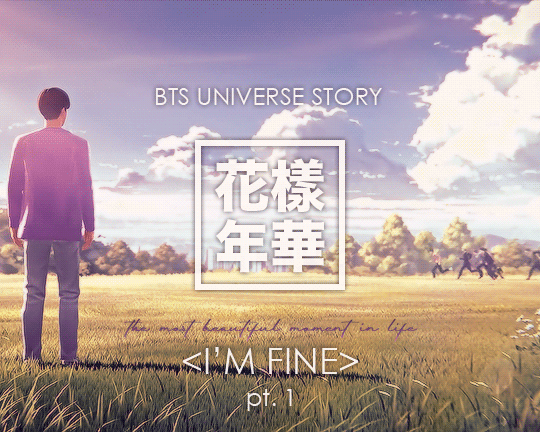
The Most Beautiful Moment in Life <I’M FINE>
BTS Universe Story Highlights, pt. 1 / 4
» pt. 2
Introduction
BTS Universe Story, a mobile game published by Netmarble, was released on September 24, 2020. While the majority of the app is essentially a sandbox and engine for users to create their own interactive stories, it also includes official and canon BU content. The first eight segments were introduced between the release date and December 2020, gathered under the title The Most Beautiful Moment in Life <I’M FINE>.
“I’m Fine” is half of the I’m Fine/Save Me ambigram introduced in the Love Yourself era. Notably, all of the BU content available in the game so far falls between events of the webtoon Save Me (also called HYYH0 in its logo) and The Notes 1—chronologically, that is, while bearing in mind that time resets to the morning of 11 April Year 22 whenever SeokJin fails to avert a tragedy among his six friends. I want to assure anyone who is unable to play the game that you are not missing any new, major plot beats from the overall BU narrative. Instead, the stories provide more insight into the motivations and consequences of SeokJin’s decisions in the earlier time loops, as well as more depth to individual characters and their circumstances.
The goal of this guide is to summarize each of the eight stories and highlight noteworthy details, especially if they are not yet present in other BU media. Within each story (which I often refer to as an arc, due to their character-focused nature), episodes must be played successively, but the stories themselves can be played in any order. I will present them over a series of posts in the order they are listed under the <I’M FINE> heading. The Prologue and NamJoon’s arc are free to play; the rest are paid content. Please note that due to the app’s Terms & Conditions, I will not include in-game footage here. The images in this guide are sourced from the official trailers/videos and the live action MVs as appropriate.
Content warning: contains references to death, suicide, suicidal ideation, child abuse, domestic violence, blood, homicide, depression, trauma, PTSD
This guide contains major spoilers and includes references to other BU media
Do not repost, copy, or quote without permission
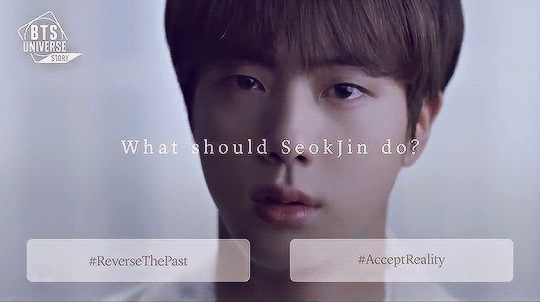
Game Mechanic
Before diving into the summaries, I would like to address the primary mechanic of the game: the user’s control of character choices at designated moments in the stories. It’s a primary marketing point that the player can influence the progression of the narrative, with a frequent in-app tip also declaring, “stories’ endings can vary depending on your choices.” The latter is not strictly true—and it cannot be true due to the structure of the game. Choices are presented within most (not all) episodes, but each episode is an isolated unit: episode 2 provides the same content regardless of what you choose in episode 1. Since the consequences of your decisions are not cumulative, each episode reaches the same ending, and each decision inevitably rejoins the “main” story path (effectively reducing the script size).
So what is the point of this mechanic? While the system is not nearly as complex as what major platform titles are capable of nowadays (I suspect due in large part to the story creation portion of the game), it does foster a sense of interaction with the narrative that isn’t present in static visual media like comics or film. The episodes with choices also have incentive for replay to discover the impact of changing a character’s dialogue or action. Sometimes the differences between the outcomes are inconsequential, but other times you unearth new details, interactions, or memories that are missing in the other path.
I say this partially in reaction to all of the comments and tweets I read for the game trailers and even Smeraldo Book twitter’s choose-your-own-adventure style teasers with The Notes 2 excerpts released last summer. Many users expressed excitement, through words or memes, about finally being able to give the boys the happy ending they deserved. I don’t fault anyone for wanting that happy ending—I wish for it, too. But no matter what the rather overzealous marketing has claimed, I don’t believe that the canon ending of BU is ever meant to be in the audience’s control. But I do feel that this mechanism fits the BU narrative. It echoes the “countless loops” SeokJin has experienced in an effort to save his friends, the choices he must make at every crossroad, and the butterfly effect those actions have on all of their lives. I think it is reasonable to interpret the simple branching paths in the game as alternatives SeokJin has explored across multiple loops in his struggle to find the “right” way forward. I’d love to hear if you have theories of your own!
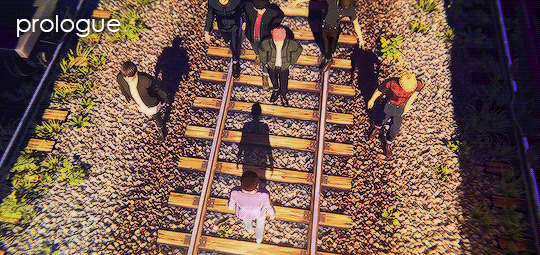
Prologue
The prologue is a brief episode introducing SeokJin’s repeated struggle and failure to save his friends. He wakes up yet again in his bed on 11 April Year 22, the beginning of the time loop. After reflecting on the tragedies that keep befalling the others, SeokJin realizes that he has only tried to fix the problems he can see. He wonders: “Have I tried to understand the root of my friends’ misfortunes? How much do I really know about my friends? Maybe I was never brave enough to confront their real scars and the worlds they’ve been living in. But I need to do it. Because it may be the key to saving them all.”
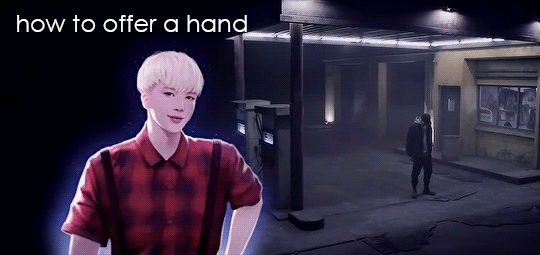
How to Offer a Hand
In this story, SeokJin attempts to prevent NamJoon’s arrest after he gets in a fight with a rude customer at Naeri Gas Station, his place of work. The first episode opens on the night of 11 April Year 22 with NamJoon curling his fists, glaring as crumpled bills lie untouched on the pavement. (The money looks similar to the shot from the I Need U MV.) SeokJin reaches for his shoulder, but NamJoon shrugs him off and strides away to punch the customer who deliberately dropped the bills for him to pick up. The gas station owner runs over at the customer’s furious shouts and orders NamJoon to apologize. He refuses, and police officers soon arrive and charge him with assault. No one listens to SeokJin’s protests that the customer started it first. The man sneers as NamJoon enters the police car. “Do you even have money for a settlement? Hey, you’re done for.” NamJoon is sentenced to prison again, and SeokJin hears glass shattering before the loop resets.
Rising from his bed on the morning of 11 April, SeokJin reflects on his failed efforts so far. He has hit the customer’s car, called for NamJoon in the middle of the incident, and stopped the fight himself, the latter of which caused his friends to avoid him later. The fight has even escalated; the details are unspecified, but the audience is provided an ominous shot of SeokJin speaking to a police officer alone at the scene. NamJoon is not the kind of person who would normally respond to that kind of provocation with his fists. SeokJin realizes that he cannot merely stop the fight but must discover and fix the true cause of it.
With this in mind, SeokJin heads to Naeri Gas Station during the day and tries to engage NamJoon. This is their first time meeting since they both returned to Songju, although SeokJin has experienced it in many loops already. “It’s been a while,” he greets (as he does at the end of the Blood Sweat & Tears Japanese version MV). Before SeokJin can dig deeper in their conversation, NamJoon is called away by his boss. SeokJin enters the small employee break room which serves as NamJoon’s living space when he’s not at the container, hoping to find some clues about his friend’s life. SeokJin locates something bundled in newspapers. If the player chooses to open it, he sees a strange shard of glass inside that may belong to a car or motorcycle headlight. He continues on, finding the book Cosmos by Carl Sagan and a notebook. SeokJin hesitates over the invasion of privacy but decides to read it since he needs all the information that he can gather. The journal entries detail NamJoon’s daily life since returning to Songju: his work at the gas station isn’t too bad despite the occasional rude customer; he purchased a book and hopes to get more in the future; he picked up a second job at a wedding hall to help catch up on bills; his brother NamHyeon got in trouble again, leading to more expenses; and his dad’s health has worsened, with hospital bills after an emergency surgery rising to levels that the family cannot afford. SeokJin knew that NamJoon was the de facto head of household due to his father’s illness but was unaware that it was to this degree. He feels sorry for NamJoon yet is also impressed by his maturity, for NamJoon never writes how difficult his situation is.
NamJoon arrives and asks what SeokJin is doing in the room. If the player chooses to answer “reading” instead of “just sitting there,” SeokJin privately observes that the conversation flows more easily when they talk about books. NamJoon says he must leave and declines when SeokJin offers to wait for him there. SeokJin knocks over a pile of books along with money and receipts as he stands. He thinks it is unusual that NamJoon picks up the books before the money. The books seem to be more than a hobby to NamJoon, holding special meaning. Walking to his car, SeokJin wonders if it is pride or determination not to falter that keeps NamJoon from journaling his grievances. He realizes that money is a constant source of frustration and misery to NamJoon, and that’s why he can’t stomach being insulted over the customer’s dropped money. SeokJin’s new plan is to prevent NamJoon from picking up the money. He also calls Palgok County Hospital and offers to pay the patient bill for NamJoon’s father. Anticipating that NamJoon will be angry if he finds out, SeokJin says the payer is Songho Foundation.
That night, SeokJin returns to the gas station with the excuse that he forgot to fill up earlier. The luxury car arrives with a honk, and NamJoon hurries over to assist. He shakes with anger when the customer drops the money on the ground. “Why aren’t you picking it up? You don’t want it? What’s with that look? Pretty arrogant for a part-timer, aren’t you?” goads the customer. SeokJin intervenes. Whether the player chooses to have him advise NamJoon not to pick it up or to order the customer to pick it up himself, the end result is the same. SeokJin asks the customer, “Why are you harassing a pitiful part-timer?” The customer drives away, and something about NamJoon seems off. His face is expressionless, not mad or humiliated. “SeokJin, you…” He stops. “Never mind. Thank you for your help.” The words sound difficult for him to speak.
SeokJin believes that he has saved NamJoon, although this ending feels sloppy. He continues on in the loop to rescue JungKook and later YoonGi, but uneasiness plagues him. Though he meant to help NamJoon with his actions, SeokJin wonders if he hurt him instead. On 5 May Year 22, he returns to the gas station and follows NamJoon when he leaves work early. NamJoon enters a bookstore, and SeokJin sneaks in after him to watch from afar. He overhears employees talking about NamJoon, worrying that he might dirty the pages of the book he’s perusing. NamJoon is too absorbed in the book to notice one of them calling for his attention. SeokJin recalls a memory from their school days when he found NamJoon reading alone in their classroom hideout: he asked why NamJoon read so diligently, and his friend explained that he found it comforting to empty his thoughts of everything else while focused on the book. In the present, SeokJin wonders how he forgot how much books mean to NamJoon. He sacrifices some of his food and transportation budget to afford them, but they enable him “to endure the weight of the world he’s forced to bear on his shoulders.” After realizing this, SeokJin wants to apologize for carelessly sympathizing with the reality that NamJoon has weathered alone.
The next episode is from NamJoon’s perspective, revealing his excitement over being able to purchase a book for the first time in two months. He wants to buy two but can only afford one. The employee at the register sighs and asks why he leafed through a book he wasn’t going to buy. NamJoon apologizes, and she mutters, “So dirty.” He notices his reflection, clothes worn and smelling of gasoline, and realizes she’s talking about him, not the book. He tries to shake off these depressing thoughts, but he is still not accustomed to this treatment despite experiencing it regularly at work. As NamJoon begins to exit the store, the security alarm goes off. The employees demand to check his bag despite his insistence that he didn’t steal anything. Their certainty of his theft angers him. NamJoon allows them to look through his bag, and they are suspicious of the like-new book in it which he brought from home. One begins to call the police until SeokJin appears, vouching for NamJoon by saying he saw everything. The employees accept that the alarm malfunctioned and excuse their suspicions as a mistake.
Outside, SeokJin asks NamJoon if he is all right. NamJoon is thankful but wonders how SeokJin materialized right when he needed him. “How’d you find me here?” he asks aloud. SeokJin explains that he happened to notice him while walking through the neighborhood. NamJoon wonders if it’s because they said goodbye on a weird note last time. He thanks him and turns to leave. SeokJin calls after him. “I’m sorry. I wanted to apologize. I didn’t mean to upset you that day at the gas station. It was a mistake to have called you pitiful. If my rash actions hurt you, I’m really sorry.” NamJoon accepts his apology, believing it to be sincere, and says that things would have turned out a lot worse if SeokJin had not intervened. Thunder rolls overhead, and NamJoon uses the impending rain as his excuse to depart. He declines SeokJin’s offer of a ride and runs home, feeling his friend’s eyes on him.
Before he can settle down to read at home, NamJoon receives a call from his cheerful mother. She thanks him for paying off the entire hospital bill. NamJoon is perplexed and asks what’s on the receipt, since he didn’t pay it. His mother wants to leave it be, but he insists that they investigate so they don’t get in trouble or sued. She reads that the Songho Foundation is credited as the payer. NamJoon calls the hospital, introducing himself as the guardian for Kim YoungMin, but they can’t transfer him to the administrative department at this time. Disappointed, he looks up the foundation’s website, unable to recall why it sounds familiar. He wonders why a scholarship foundation in the city would get involved with him. Spotting photos of a recent launch ceremony on the site, he recognizes a few people: Songju High School’s principal, the familiar-looking face of the foundation’s chairman, and SeokJin. First, NamJoon forces a laugh, and then it’s difficult for him to breathe. He thinks that SeokJin really had pitied him at that moment. The only thing keeping NamJoon going is the idea of getting through life on his own strength. Why does he have to live like this?
The last episode opens on 5 May back in SeokJin’s perspective. He is confident now that he has saved NamJoon, although it occurs to him that a better alternative may have been to simply pick up the money himself instead of stepping forward. (This decision is enacted in a later loop and depicted in the Euphoria MV.) While reflecting on what comes next to save his other friends, he receives a text from NamJoon. “What’s your account number? I’ll pay you back for the hospital bills. I don’t need your help. I’ll handle my concerns on my own.” Heart sinking, SeokJin wonders how he found out. With a sense of foreboding, he tries calling NamJoon, but no one answers. SeokJin texts him back, pretending that he doesn’t understand, and tells NamJoon to call him. SeokJin’s second attempt connects while he’s gathering his car keys to visit the container. “That’s enough. Just send the account number over text,” NamJoon instructs. SeokJin coaxes him to talk for a moment, and NamJoon asks flatly, “Are you going to apologize again?” SeokJin attempts to salvage the situation, but his friend turns cold when he insists that NamJoon is misunderstanding and that he just wanted to help. “So, why? Why are you helping me?! Yeah, you’re always a good person. You’ve done nothing wrong and I’m the one misunderstanding.” SeokJin apologizes again. NamJoon refuses his request to meet in person. “No, I thought maybe there was a reason for everything you did… But I guess I misconstrued it. I’ll pay you back, so I’d prefer if you stopped contacting me.” Long after the call ends, SeokJin stands holding his phone, feeling that the glass is going to break at any moment. He wants to believe that it’s not over, but hope is slipping through his fingertips.
The episode finishes in NamJoon’s perspective. On 8 May and 9 May, he accepts part-time delivery work and reflects on his three jobs. Whenever he thinks he’s at his breaking point, he focuses on his new goal of returning SeokJin’s money. On 10 May, NamJoon wakes up to his buzzing phone and is called in to work. On a scooter, he passes by a bus stop and notices graffiti. (This is the same bus stop, with matching graffiti, that appears in the Highlight Reel.) Mesmerized, he wonders if it’s TaeHyung’s. As soon as NamJoon looks up, the scooter’s brake fails, and he crashes. The shattered glass on the cold pavement reminds him of the headlight shard and the kid who looked like TaeHyung. (So the piece of glass SeokJin saw in April was really a memento NamJoon retrieved from the scene of the crash in the mountain town, where the delivery boy whom he privately called TaeHyung died. This event is described in NamJoon’s 17 December Year 21 entry in The Notes 1.) NamJoon’s vision grows blurry, and the distant sound of an ambulance doesn’t come any closer.
The arc concludes there, but it obviously marks another reset for SeokJin. It is interesting to note that in this failed loop, NamJoon suffers the same fate that he narrowly avoided in the snowy mountain town before returning to Songju.
Please stay tuned for the next Highlights post featuring JungKook and YoonGi!
#armiesnet#networkbangtan#bangtanarmynet#armysource#dailybangtan#bts universe#hyyh#bangtan universe#bts universe story#bts universe story highlights#seokjin#namjoon#namjin#bts theories
158 notes
·
View notes
Text
Happy 291st Birthday, Lord John Grey! - A Natal Chart Reading for our dearest English Lord
This is very different from what I usually share here. By now you are all aware that we are celebrating the 291st birthday of Lord John Grey of Outlander.
For this occasion I took it upon myself to do a natal chart reading for him.
This is astrology applied to a fictional character, you have been warned. Continue at your own discretion.

Disclaimers:
I am not an astrologer
This is made in the spirit of appreciation of this character and his story. The purpose of this is pure fun on my part and hopefully to entertain some of you as well. Plus, maybe to provide some character-study-style insight or inspiration.
The character of Lord John Grey belongs to Diana Gabaldon - duh
John’s birth date is canon. The time has been arbitrarily chosen by me. Yes, it is important, because there are a lot of moving parts to a natal chart. I have literally cycled through the day by the hour, compared charts and decided on the one that I’ve found most fitting to his character. Which, is by the way best practice, when you do not know your or someone else’s exact birth time, but are somewhat familiar with their character. And considering that even if our dearest Lord John were an actual historical figure, I’m pretty sure we wouldn’t have his exact birth time from 1729, so I don’t feel bad about my process.
The examples I may give here are both from the books and the show, but nothing too specific that would be considered spoiler.
Lastly, this is all my interpretation both about the astrological meanings and of his character. Feel free to disagree with me. Politely, if you please.
So, in good Outlander time-travelling fashion let’s transport ourselves back to the day Lord John Grey was born and look up to the sky to see what it has to tell us.
Sun in Gemini
Lord John is a Gemini, which makes him clever and witty. He takes pride in his intellect and uses it to reach his goals. He is extremely adaptable, and instantly finds his footing in the most various settings, whether that’s London’s high society, a remote village in Scotland, or a two week fishing trip in the wilderness of the Colonies.
As someone born under the sign of the Twins there is a natural duality to his personality, that we can observe many times. He is capable of great tenderness, yet he can also be extremely fierce. Brutal is perhaps not the right word, but as much as he is a gentleman, we do see him engaged in physical fight, where he is by no means unskilled. You can’t say it’s always self-defense either.
He often has an internal conflict between heart and mind, between duty and emotion.
Geminis make good actors, and Lord John is exceptional in that too. He has to be as a gay man in the 18th century, which creates another duality between the life he’s supposed to live as a solider and as a Lord, a respected member of high-society and all the things he craves but has to hide.
As a Gemini he is a great communicator. Good with people, small talk comes easy for him, but engaging in a deep intellectual conversation is what really fires him up (Shakespear, anyone? :P) He is pleasant to be around and has a good sense of humour. His skills are diverse and he makes friends easily as he moves from one adventure to the other.
Geminis are prone to restlessness, which Lord John demonstrates beautifully by fidgeting with every little knick-knack that accidentally lands between his well-manicured hands. (Why does he stash them away in his pockets? I’m afraid astrology has no answer for his accidental kleptomania.)
His Sun is in the Ninth House of mental and physical explorations. Long journeys of the mind and the body are prominent in his life and essential to his personality. He speaks multiple languages and uses them to express himself on a very personal and natural level - aka swearing in the language most appropriate to the level of shit he’s gotten himself into this time.
Libra Rising
His rising sign is Libra, which sheds light on how he presents himself and what he wants to be known for. People with Libra Ascendant have natural grace and a good style. Lord John has all of that and finds himself often in the spotlight for it. He doesn’t have to struggle to be successful, but more than anything he wants to be known as a kind and loving person, and I would argue he succeeds in that.
His rising sign is important, because his natal chart is ruled by Venus, the planet of love and beauty. He has a romantic nature, and has the ability to connect with anyone, anywhere at any given time.
Libra rising people are said to be very attractive and compatible with almost anyone and as we say around here Lord John Grey would have chemistry with a lamppost.
This doesn’t just extend to romantic partners, although he is the happiest when in a romantic relationship. He puts others at ease and is genuinely likeable.
He feels obligated to balance the situations he finds himself in, therefore he is a natural diplomat always striving to harmonize and negotiate. It also makes him a good listener.
He has a great sense of fairness and injustice angers him. He is social, has a generally positive outlook on life and is inspired by nature and art.
Moon in Aquarius
The moon sign represents the hidden side of someone’s personality, their emotions, their needs. It is also jokingly referred to as the “drunk you”, so let’s see who Lord John is after a few glasses of good Scottish whiskey.
At first glance there is nothing scandalous here, Aquarius is the most favorable sign for the Moon to be in. This gives him sensitivity and good perception. He tries to understand others’ perspective, and is rather idealistic.
However, people with the Moon in Aquarius are prone to sudden outbursts. How many times does he put his foot in his mouth and gets punched or called out to a duel for it? Yeah…
He can also push other’s over the edge emotionally, exactly because he is so perceptive, which actually does happen when he is drunk. This is not out of malice, but either out of pure authenticity or just because he knows it will get the other person out of a place of stagnation.
He hides a rebellious, progressive and unconventional soul under that well-tailored waistcoat of his and it does come out sometimes.
Ideally he needs to have a healthy outlet for this, a partner who appreciates his sometimes idiosyncratic nature and occasional eccentricities. In turn he won't flinch in the midst of the most challenging situations, because he’s not afraid of chaos.
He wants to find solutions that work for everyone and can neglect his own needs in the process.
If that wasn’t enough air for you, he also has a-
Grand Fucking Trine in the air signs
Which is a pretty big deal. (Moon in Aquarius - Pluto in Libra - Neptune and Mars in Gemini)
These influences all help and strengthen each other. He has a brilliant mind, his Intellect is exceptional, he has a deep concern for law and duty, and an unusually sharp sixth sense of unearthing shocking revelations.
He has a magnetic personality, great ability to express himself, and therefore leaves a lasting impression on others. He is able to inspire and lead others and his need for harmony and cooperation makes him a great negotiator.
Lots and lots of air influence, which also means that in the battle of the mind and the heart unfortunately the mind wins and he lets his heart break instead.
Let’s get back to Venus and love for a sec.
With this much air in the chart for him everything starts in the mind. He experiences desire in the mind first. He must have a great intellectual connection with someone, before their relationship could blossom into a romance (Venus in Gemini). His entry point to sex is also through words (Mars in Gemini). Think about all the witty foreplay and low-key dirty talk in the LJG books. And also, khm chess games...
Where does that occasional intensity and dominance come from, you ask?
Well, he does have Uranus in Scorpio (semisquare Venus in Gemini, semisquare his Sun in Gemini) which would explain why he is not always displaying the lighthearted, fun, fleeting ways of a Venus-in-Gemini lover. He does have a lot of sexual partners. But then we’ve already established that he would have chemistry with a lamppost.
His chart is heavy on the 9th and 10th houses of long distance travel, career and public standing, and these are probably the most important aspects of his life. He is a comparatively lucky person, with a lively social life, charming personality and strong morality (Jupiter in Cancer).
His great trauma lies in what squares Neptune and Mars in the 9th house. There is an opposition between his sexuality and dreams, and what ideas he is allowed to express publicly. He is sensitive to what others think (Mercury in Cancer), picks up signals very well and is therefore acutely aware of what he can and cannot say.
Here lies the greatest disappointment and loss in his life (Saturn in Pisces). He chooses to make personal sacrifices for the benefit of others.
His Chiron is in the 7th house of partnership and marriage, which I also find interesting. This minor planet get’s called the Wounded Healer. It makes me think about what Claire and Jamie says about wounds and Lord John. And it also makes me think about his marriage.
Well, if that doesn’t make for an interesting personality, I don’t know what does. I hope this has been at least half as fun to read as it was to write. Let me know what you think.
46 notes
·
View notes
Text
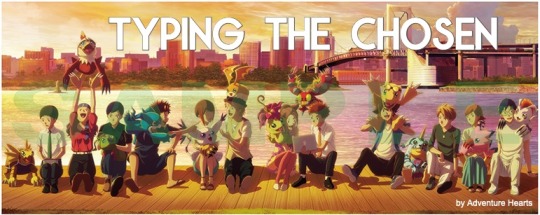
( PART 1: DA + ASTROLOGY )
PART 2: DIGIMON ADVENTURE + MBTI
Taichi - ESTP Yamato - INFP Sora - ENFJ Koushirou - INTJ Mimi - ESFP Jou - ISTJ Takeru - ENFP Hikari - ISFP Daisuke - ESFP Miyako - ENFP Iori - ISTJ Ken - INFJ
Discussion and Commentary below!
If you’ve read some of my previous headcanons about the MBTI, and in particular this very popular post from four (!) years ago, you may find I’ve changed my mind a lot.
An important thing about this typology (or any other one, really) is that it’s quite easy to just look into some websites and make decisions based on the keywords used to describe each type. Which is what I used to do. Keywords are helpful to help us get the “basic picture” (hence why I quote them in this post), but now I believe that you have to read actual theory in order to understand the subtle differences between each type and make more educated guesses.
Since then, I’ve been reading more deeply into MBTI and the Functions. Consequently, the way I understand the MBTI has changed significantly, and so have my Headcanons.
It’s been particularly interesting to learn about the Inferior Function, or the “dark side” of each personality type. The more I read about it, it became surprising that how it seemed to describe most of the adventure kids’ characters arcs incredibly well. This is another reason why the combination Chosen Children + MBTI is such a fascinating and fun thought exercise!
It should be noted that different authors can have widely different interpretations of types, which is why, for the sake of simplicity and coherence, I’ve only read 3-4 main sources when preparing this post. And I tried stay away from popular MBTI websites and resources that exist around the internet, most which can have a slightly misleading/superficial vision of each type.
However, this doesn’t mean my HCs are “RIGHT” or that other people can’t have better ideas. I’m as biased about the characters as anyone else. I’d be very happy to hear alternative takes!
***
Taichi - ESTP Dominant function: Se
Flexible and tolerant, they take a pragmatic approach focused on immediate results. Theories and conceptual explanations bore them - they want to act energetically to solve the problem. Focus on the here-and-now, spontaneous, enjoy each moment that they can be active with others. Enjoy material comforts and style. Learn best through doing.
Taichi is pretty easy to type, and most ESTP descriptions fit him nicely. Thompson notes the archetype of ESTP is James Bond and Xena the Warrior Princess; I think the character of Taichi, who represents Courage, fits in the same tradition — a bold, impulsive, adventurous leader who is good at strategizing and is able to make though decisions, but is is also very charismatic and charming. Taichi’s tendency to become thoughtful, introspective, and indecisive under stress can be explained by the inferior function, Ni.
Yamato - INFP Dominant function: Fi
Idealistic, loyal to their values and to people who are important to them. Want an external life that is congruent with their values. Curious, quick to see possibilities, can be catalysts for implementing ideas. Seek to understand people and to help them fulfill their potential. Adaptable, flexible, and accepting unless a value is threatened.
By contrast, Yamato is always the most difficult to type! I ended up using INFP rather than INFJ, because I think it makes more sense for his dominant function to be Fi (introverted feeling): “Due to the introverted nature of Fi, INFPs’ status as feelers is not always evident from without. When immersed in Fi, they can seem a bit cool, aloof, or indifferent.“ (Drenthe). This type is pretty well representative of Yamato’s caring, passionate and caring side, and especially his conflict during Adventure is beyond, his search for self and meaning. Yamato’s more critical, aggressive, angry, and impetuous side is easily explained by him falling under the influence of the inferior function of this type, Te.
Sora - ENFJ Dominant function: Fe
Warm, empathetic, responsive, and responsible. Highly attuned to the emotions, needs, and motivations of others. Find potential in everyone, want to help others fulfill their potential. May act as catalysts for individual and group growth. Loyal, responsive to praise and criticism. Sociable, facilitate others in a group, and provide inspiring leadership.
Another character who’s relatively difficult to type. I see Sora as being in the middle of many of the Preference axis, hence why I initially typed her as something pretty difference different. But now I’m pretty convinced her dominant function is Fe, even though she’s probably only 51% Extroverted. She leans more towards iNtuition than Sensing: Sora’s definitely someone who can pick up things intuitively, especially when it comes to human relationships. So, ESFJ could probably work as well, but I see her as more of an NF type than a SJ type. Sora’s tendency to become hypersensitive, stubborn and withdrawn when under stress? That’s the inferior function, Ti.
Koushirou - INTJ Dominant function: Ni
Have original minds and great drive for implementing their ideas and achieving their goals. Quickly see patterns in external events and develop long-range explanatory perspectives. When committed, organize a job and carry it through. Skeptical and independent, have high standards of competence and performance - for themselves and others.
This is an example of how learning more about Functions made me change my mind! I believe Koushirou is the text-book definition of INTJ and the Ni function. Koushirou isn’t just someone who thinks — he creates knew knowledge and connects theoretical possibilities. One of the effects of the inferior function of this type, Ni, is an “Obsessive focus on external data”, which means that they can become obsessed with controlling small details, which is what Koushirou tends to do under stress.
Mimi - ESFP Dominant function: Se
Outgoing, friendly, and accepting. Exuberant lovers of life, people, and material comforts. Enjoy working with others to make things happen. Bring common sense and a realistic approach to their work, and make work fun. Flexible and spontaneous, adapt readily to new people and environments. Learn best by trying a new skill with other people.
Mimi is a rather obvious fit for this type, not only with her bubbly and happy exterior, but also her naïveté and compassion towards others (Crest of Purity).
Jou - ISTJ Dominant function: Si
Quiet, serious, earn success by thoroughness and dependability. Practical, matter-of-fact, realistic, and responsible. Decide logically what should be done and work toward it steadily, regardless of distractions. Take pleasure in making everything orderly and organized - their work, their home, their life. Value traditions and loyalty.
Jou’s type seems pretty straightforward. The characteristics of this type to fit him (and the Crest of Honesty) very well. The inferior Function of this type is Ni, manifested as impulsiveness and catastrophizing — classic Jou moves whenever he looses his cool.
Takeru - ENFP Dominant function: Ne
Warmly enthusiastic and imaginative. See life as full of possibilities. Make connections between events and information very quickly, and confidently proceed based on the patterns they see. Want a lot of affirmation from others, and readily give appreciation and support. Spontaneous and flexible, often rely on their ability to improvise and their verbal fluency.
Takeru is REALLY hard to type. Mostly because, just like his brother, he isn’t as transparent as he seems. Behind that charming, open, happy façade, Takeru runs deep. I ended up choosing ENFP is described as the most optimistic of all types (Crest of Hope), and they are very charismatic and inspiring as well. The “dark side” of this type can be hopelessness or depression (see also: tri. Chapter 3!)
Hikari - ISFP Dominant function: Fi
Quiet, friendly, sensitive, and kind. Enjoy the present moment, what's going on around them. Like to have their own space and to work within their own time frame. Loyal and committed to their values and to people who are important to them. Dislike disagreements and conflicts, do not force their opinions or values on others.
Hiakri is another one whose type isn’t obvious, but maybe for different reasons than the other characters I hesitated about — we just don’t see enough of her. I think you can make a strong argument for her being an Intuitive type, but ultimately I think Fi represents her better.
Daisuke - ESFP Dominant function: Se
I know it’s reductive to say Daisuke and Taichi have different personality type, but that’s easy to understand if you see them as being in different stages of type development.
Miyako - ENFP Dominant function: Ne
I’ve always thought Takeru and Miyako are pretty alike, hence why I think they would both fit this type.
Iori - ISTJ Dominant function: Si
Again, Iori and Jou are pretty alike, although at different stages of their personality development. I could see Iori a ISTP/ISTJ, too — to be fair, I haven’t made up my mind totally about him.
Ken - INFJ Dominant function: Ni
Seek meaning and connection in ideas, relationships, and material possessions. Want to understand what motivates people and are insightful about others. Conscientious and committed to their firm values. Develop a clear vision about how best to serve the common good. Organized and decisive in implementing their vision.
I’m just going to go and give Ken INFJ, although I’m not entirely sure it is the best fit. Ken is incredibly complex, but Ni seems to describe him fairly well. And certainly, the “dark side” of Ni, Se, can very well explain why Ken developed his Digimon Kaiser persona.
BONUS
A brief summary of the 8 Functions:
Introverted Intuition (Ni) collects conscious and subconscious information, and then synthesizes it to produce convergent impressions, insights, answers, and theories. It sees deep causes, patterns, and laws underlying sense data. It is characteristically penetrating and insightful.
Extraverted Intuition (Ne) surveys and creatively recombines a breadth of ideas, associations, patterns, and possibilities. It is characteristically innovative, divergent, open-ended, and non-discriminating. Outwardly, Ne users may present as scattered, random, quirky, witty, and ideationally curious.
Introverted Sensing (Si) retains, consolidates, and recollects historical and autobiographical information. It attends to and draws on a concentrated body of past experiences, routines, and traditions (i.e., the “tried and true”). It forgoes the constant pursuit of new or broad experiences, finding safety and security in stability and consistency. It also surveys inner bodily sensations.
Extraverted Sensing (Se) seeks extensive outer stimulation in the “here and now”—new sights, sounds, tastes, experiences, etc. It is open-ended and non-discriminating with respect to new experiences. It can also be associated with image-consciousness and observation skills, displaying a keen eye for detail. Outwardly, it may manifest as a recurrent desire for activities beyond talking (“Let’s do something!”).
“Introverted Intuition (Ni) collects conscious and subconscious information, and then synthesizes it to produce convergent impressions, insights, answers, and theories. It sees deep causes, patterns, and laws underlying sense data. It is characteristically penetrating and insightful.
Extraverted Intuition (Ne) surveys and creatively recombines a breadth of ideas, associations, patterns, and possibilities. It is characteristically innovative, divergent, open-ended, and non-discriminating. Outwardly, Ne users may present as scattered, random, quirky, witty, and ideationally curious.
Introverted Sensing (Si) retains, consolidates, and recollects historical and autobiographical information. It attends to and draws on a concentrated body of past experiences, routines, and traditions (i.e., the “tried and true”). It forgoes the constant pursuit of new or broad experiences, finding safety and security in stability and consistency. It also surveys inner bodily sensations.
Extraverted Sensing (Se) seeks extensive outer stimulation in the “here and now”—new sights, sounds, tastes, experiences, etc. It is open-ended and non-discriminating with respect to new experiences. It can also be associated with image-consciousness and observation skills, displaying a keen eye for detail. Outwardly, it may manifest as a recurrent desire for activities beyond talking (“Let’s do something!”).
“Introverted Thinking (Ti) utilizes deep and nuanced logic to examine techniques, problems, concepts, or theories. It seeks self-regulation and self-optimization through the development of personal skills, methods, and strategies. It takes a skeptical and reductive approach toward knowledge.
Extraverted Thinking (Te) uses explicit logic, including standardized methods, measurements, policies, and procedures, to make systems and operations more rational, efficient, or effective. This often involves working as part of an institution, be it corporate, scientific, academic, etc. Outwardly, Te delivers opinions and directives in a firm, direct, measured, and unemotional fashion. It may at times be perceived as harsh, tactless, or unsympathetic.”
“Introverted Feeling (Fi) explores and refines personal tastes and feelings, contributing to a strong sense of personal uniqueness. It is self-regulating and self-controlling, working to maintain inner emotional and moral order. It may also emotionally invest in a limited number of love objects, be they persons, animals, hobbies, or causes.
Extraverted Feeling (Fe) surveys a breadth of human emotions, values, and morals. It strives toward interpersonal rapport, consensus, and continuity. It can also be associated with effective communication and social intelligence, facilitating growth and transformation in others. Outwardly, it delivers opinions and directives in a direct yet tactful way, often with a sense of emotional urgency and conviction.
in My True Type, A.J. Drenth
MBTI RESOURCES
A.J. Drenth. “My True Type”
Lenore Thomson. “Personality Type”.
A.J. Drenth. “The 16 Personality Types”.
The 16 MBTI® Types https://www.myersbriggs.org/my-mbti-personality-type/mbti-basics/the-16-mbti-types.htm
Naomi Quenk, “Was That Really Me?”
#series: typing the chosen#digimon#headcanons#personality types#mbti#sorry but Tumblr formatting is a MESS;;;; I hope it's more readable now!
35 notes
·
View notes
Text
Edgar Valden 4w5 ISFP
[[16 September 2020
Originally written as a comment thread on PDB]]
While we all seem to agree that Edgar is undoubtedly a 4, it seems that there has been some debate over his wingtype; based on the newly released information for him, I would argue that Edgar is a clear example of a 4w5. In fact, his enneatype also feeds into the disagreement over his MBTI (and vice versa).
To begin, here is a direct translation of his character summary, also featured as the brief description on this profile:
“The only son in the Valden family of aristocrats, Edgar showed an interest and high talent in painting from childhood. Praise from his family and the public has led to his eccentric character. His perception of the world around him led to his belief that nobody else is worthy to speak to him about art.”
A surface-level look at this may suggest to some a 3 wing, for the simple fact that “praise from the public” is mentioned. However, the key here is that it has resulted in his becoming an “eccentric character”, a label the 4w3 is less likely to be assigned than a 4w5. The influence from the 3 gives the 4 a bit more awareness of social expectations and appearing “acceptable”, but a 5 wing gives the 4 an even more deeply introspective and self-referential worldview. Any enneatype can receive public praise; it’s how the person reacts to it that truly indicates their personality type.
This description of his character also pairs well with Fi > Fe, as in (an unhealthy) use of dominant Fi in the ISFP; Edgar displays absolutely no Fe. He is not interested in the feelings or opinions of others. In fact, what frustrates him is that nobody else seems to understand how he feels, which in his mind is obviously the only correct way to see and understand art.
His character trailer only further cements the interpretation of an emotionally-driven, authenticity-seeking 4w5 ISFP:
“All that is beautiful in this world; once upon a time, that was the inspiration for my paintings. But slowly, they stopped looking so cute to me. The plebeians, you see, they do not revere art, because they will never grasp it. Hypocritical and double-faced, avaricious and insatiable, obstreperous and useless. None amongst you can speak with me on the true essence of art.”
“And when this place can bring me pleasure no more I can only hope that that paradise will bring me yet unknown inspiration.”
His arrogance is not the pride of a 3 wing; it is more in line with the sense of pseudo-intellectual superiority of a 5 wing. He feels that the people around him cannot possibly understand the depth, the “true meaning” behind art. We can see this further reflected in how he describes the “plebeians”:
“Hypocritical and double-faced, avaricious and insatiable, obstreperous and useless.”
Here, there is a clear emphasis on the values of the 4 — authenticity, deep feelings, a sense of meaning — alongside an outright rejection of the 3’s social masking. The passion of the 3 is deceit, which manifests as molding the self into the vision of “success” or being “productive”. A 4w3, especially a less healthy one, struggles to balance the inner need to express themself and the desire to maintain appearances or be in style, one way or another.
The 4w3, because of the assertive Hornevian type of the wing, is also more openly competitive and ambitious, and tends to be more socially extraverted than a 4w5. With a 3 wing, Edgar would be driven to not only express himself creatively, but would also desire success — he would self-promote in order to gain recognition. His character trailer clearly expresses that his struggle is not lack of praise for his work; rather, it is a feeling of hopeless longing, of having a rich internal world that nobody can understand.
This aspect of Edgar’s character is far more the struggle of the unhealthy 4w5. With a doubly introverted frame of reference, the 4w5 is more prone to getting lost in the fantasy world they have constructed; anything that doesn’t meet this set of expectations is derided as being “inauthentic” and discarded. Moreover, even the choice to describe people with words like “two-faced” and “obstreperous” points to a 4w5. We see in the first adjective the 4’s concern with presenting only one’s inner truth, and in the second an aversion to loud and aggressive mannerisms, as well as a discontentment with others’ expectations.
His distaste for hypocrisy is presented to the viewer, and is not then followed by an ironic twist where Edgar himself is shown to be engaging in such behavior (as in other character trailers); therefore, it’s safe to say that he presents himself true to his beliefs, and is generally neither loud nor demanding. Again, with influence from 3, we would expect to see some of these traits reflected in his character; their absence, along with the presence of the more ruminative melancholy, make clear a 4 with an influence from 5.
Edgar’s reverence of art and its “true essence”, on top of the stylistic choice of the trailer itself, further lends towards such a reading. While the artistic direction of the animation could simply be because he’s an painter, this idea could easily have been conveyed using any number of alternate techniques. The choices made were deliberate — or at least, in such productions, should be — and as such, can be taken thusly.
As always, the trailer is in the first person, and is meant to reflect his own perception of the world. By framing Edgar’s entire life as being contained within various paintings, of being defined by the abstract or intangible “essence”, the video suggests that he is living inside his own head, with all external input being filtered through his own personal values and beliefs. This is both the realm of the 4 (especially wing 5) and an ISFP using unhealthy Fi.
Further support for this can be found in the word choice of the original Chinese: the version of the pronoun “they” used in the opening lines:
“All that is beautiful in this world; once upon a time, that was the inspiration for my paintings. But slowly, they stopped looking so cute to me.”
This version of “they” in Chinese is only used for people, not objects or a concept. However, the handling of the “they” in question is the same way one would talk about something non-living. In other words, Edgar sees people primarily as objects of inspiration for his own creativity; the things he experiences in the real world are heavily filtered through Fi, and (before his further deterioration in health) shaped into whatever he needs them to be to inspire him to create.
From this quote, we also know that his primary extraverted function must be perceiving. His natural instinct was to draw his inspiration from direct observation of the physical world around him, rather than being able to generate it fully from within. When describing his motivation for going to Oletus, Edgar says:
“And when this place can bring me pleasure no more I can only hope that that paradise will bring me yet unknown inspiration.”
This supports both the 4’s search for that “missing something” and an ISFP’s need for Se input to support dominant Fi. Furthermore, as an artist, Edgar uses his Se not only to take in sensory information, but also as an outlet for his Fi. By creating art, he’s able to express his emotions and intangible inner landscape in a way that others can experience, and hopefully, understand.
He does not search for connections between ideas or people like a Ne-user, nor does he focus on making quick or logical decisions like a Te-user. Sure he’s judgmental, but it comes purely from a place of emotion, not reason or anything more concrete than that he finds humanity as a whole to be ugly and worthless. This points to unhealthy Fi and inferior Te.
Edgar’s focus on the “true nature” of art and his feelings of disillusionment with humanity is the result of his dominant Fi and tertiary Ni; together, his Fi and Ni create for him a bottomless well of emotions where he holds a sense of art’s essential “essence” and a need to find meaning in everything he experiences. Without these things, he has no inspiration, and therefore must seek out a new external environment (Se) to feed his internal one. With unhealthy Fi, Edgar has gotten so deeply entrenched in his own vision of the world that he has let it overwhelm him, and his Fi interpretation of his Se has become excessively negative.
The Fi’s need for authenticity and confidence in its own internally-held ideas can come across as equally harsh as a dominant or auxiliary Te-user’s criticism. The key difference here is that while the Te’s aggression comes from a frustration at others’ lack of logic or practicality, the Fi’s hostility comes from feeling misunderstood or personally attacked. While Edgar may have Te, it is clearly his inferior function. Not only is he not primarily driven by external decision-making, the way he does use Te is to serve his Fi. In ISFPs, the Te is relied upon when their Fi holds an opinion strongly enough that they feel they must take action on it. This is especially true when under stress or defending against perceived threats; when in such a state, ISFPs can become incredibly critical of others, and will state their Fi beliefs in a matter-of-fact, Te style of speaking. In Edgar, this is what has created his attitude of “None amongst you can speak with me on the true essence of art.”
Further evidence for Edgar having the ISFP function stack is held within his third external trait:
“The Painter focuses on the sensations behind real objects. Therefore, he is not afraid of progress when sitting on a rocket chair. When a Painter is put on a rocket chair for the second time, the progress in sitting on the chair continues from the moment he was last placed.”
Aside from meaning that he can be chaired four times, this external trait is interesting in its title. The Chinese characters used for the first word confidently translates into “sensitive” (as in emotions), while the second word can be translated two different ways. The second word is used to mean either “direct observation” or “intuitive”. Therefore, a full reading of this trait can be either “emotional sensing” or “emotionally intuitive”.
Furthermore, the trait description itself lines up with a function stack that leads with Fi: “The Painter focuses on the sensations behind real objects.”
This is just shy of having “Edgar leads with feeling” outright stated. Moreover, it supports auxiliary Se, where he uses his Fi as the primary way to understand the external stimuli he receives. This more internally-focused way of engaging with reality once again supports a 4w5 reading over 4w3; Edgar is not driven to use his creativity in a way that would generate professional success. He is creating for creativity’s own sake, to express something that is true to his vision of art.
Also in Edgar’s profile are the character traits “arrogant, paranoid, neurotic”. Coupled with his “eccentric character”, this solidly places Edgar as a 4 with a 5 wing, with a clear influence from the 5 in his paranoia and neuroticism. While Edgar seemed to enjoy the praise heaped upon him, this does not automatically indicate a 3 wing. The 4 is just as capable as the 3 of basking in praise; after all, it feeds into the 4’s need for specialness just as much as it does the 3’s need for outstanding achievement. However, we see for Edgar that this praise was not enough; ultimately, the attention was worthless because nobody could understand the true essence of his work, or grasp the deeper meaning behind it.
Edgar’s emotional rejection of his adoring public continues to support a 5 wing. At average to unhealthy levels, 4w5s retreat into an at times bizarre fantasy world that to them appears real. The elitist and eccentric nature of the 4w5 leads to an ever-intensifying internal search for an expression of the genuine and unique self. They can appear to “push the edges of sanity” in pursuit of this, which ties into Edgar’s description as being “neurotic” and “paranoid”.
As the 4w5 decreases in health, the feelings of emptiness and isolation grow, and their image of the world becomes increasingly bleak. Just as in Edgar’s trailer, the world, once rose-tinted and romanticized, is slowly transformed into a grotesque or ugly place; humanity becomes a breed of irredeemable, ignorant or sick creatures. There is a wallowing in the hopelessness and magnification of feelings (that then get bottled up inside) resulting in a negative feedback loop. This is the sort of state that the letter finds Edgar in, and what draws him to Oletus.
The trailer makes it clear that Edgar’s acceptance of the Manor’s invitation is based entirely on his desire to complete a work that will satisfy himself, and only himself. He is not interested in gaining recognition for it. Rather, he sees it as a cure for his own sense of longing — nothing has been able to satisfy him.
On the other hand, the 4w3 tend more towards social extraversion, and are more likely than 4w5s to directly share their overwhelming feelings. Even at decreasing health levels, the 4w3 has more of the performative nature of the 3 than the withdrawal of the 5. The 4w3, when under stress, attempts to magnify the emotions they identify as “genuine”, paradoxically losing touch with their true feelings. There is a theatrical quality to their emotional displays not present in the 4w5; this serves to cover up their inner feelings of an emptiness that can’t ever be filled. Rather than an attachment to a fabricated inner landscape, the 4w3 exhibits a clinging to the external expression of manufactured emotions.
One of the few things I can think of in terms of how Edgar could be mistaken for having a 3 wing is that he has so in his instinctual stack; however, even with this, Edgar is sp/so, which in theory should make his 5 wing more obvious. As for how his enneatype and MBTI can cause mistyping in one or the other, I do have a few ideas. When exhibiting the highly critical and arrogant nature of an unhealthy 4 — especially with a 5 (mind center) wing — a character may have Te ascribed to them. However, their strong words and actions are ultimately tied to emotions, not logic; with auxiliary Se serving unhealthy Fi, the choices made are impulsive (Se) rather than decisive (Te).
Additionally, I can perhaps see some mixup regarding his sweeping statements about art’s underlying nature. This can be seen perhaps as him being a Ne-user, or either a dominant or auxiliary Ni-user. In fact, this ties back into the 5 wing; the 5 is interested in creating a mental theory of the world, or some particular part of it. This “big picture” thinking is characteristic of strong intuition users. However, we see with Edgar that of higher importance is his own subjective values; art has a certain essence because he believes it to be so. This sense of what art “truly is” cannot be Ne, because it’s derived entirely from connections made between his own internal feelings and “gut sense”, rather than between things in the world around him. It is not dominant or auxiliary Ni, because his Fi is much stronger. Once again, this ties back to Edgar’s 4 base, and to his unhealthy use of dominant Fi.
In short, Edgar displays none of the traits or motivations characteristic to the 4w3, and has a function stack that even at a cursory glance simply cannot lead with thinking or intuiting. Given the information provided by both his trailer and the Chinese character profile, I cannot see Edgar as being anything other than a 4w5 ISFP.
#identity v#idv#idv painter#edgar valden#long post#mbti#isfp#enneagram#enneatype#4w5#ennea 4#personality database#character analysis
6 notes
·
View notes
Text
166. Sonic the Hedgehog #98
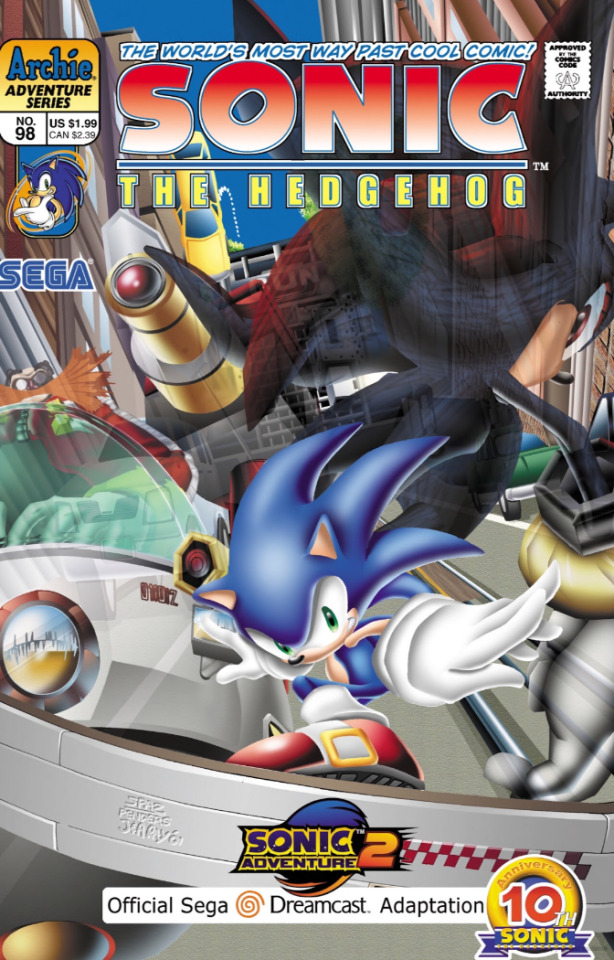
Sonic Adventure 2
Writer: Karl Bollers Pencils: Patrick "Spaz" Spaziante Colors: Patrick Spaziante and Nelson Ribeiro
Welcome to Sonic Adventure 2, everyone! Now, you would be excused for thinking that the comic would want to handle such a highly anticipated and ultimately successful game in the same manner as it did the first one, but you would be wrong! I'm going to spoil it for you right now - we only get part of the story in the comics. This one issue used to cover the entirety of the game, and as we'll see this presents some serious problems. But let's dive in, I'll save my rants for after we go over everything.
So our story doesn't actually begin where the previous issue left off. Instead, it begins three months ago, right on the tail end of the previous Sonic Adventure, in fact. The comics never really did address exactly what happened to Eggman in between being chased out of Station Square by Silver Sonic, and returning to Robotropolis. Well, as it turns out, he ended up being chased, somehow, all the way to one Prison Island, where Silver Sonic cornered him and blasted the ground out from under him, causing him to fall down a dark hole. Satisfied that it had killed him, Silver Sonic returned to Station Square to resume its defensive protocol there, but in actuality he had fallen into a secret lab with something very interesting hidden inside…
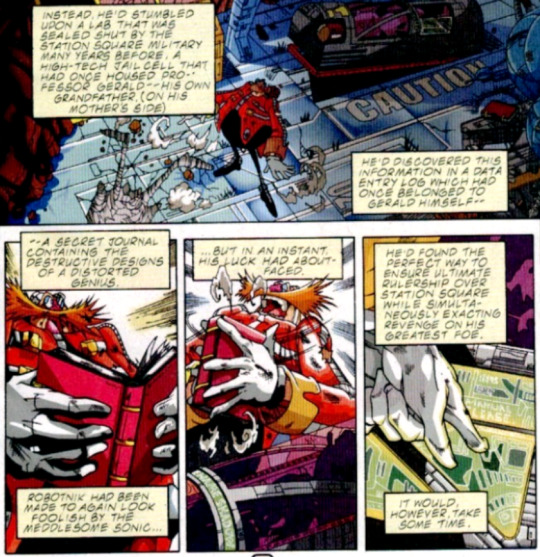
Now fast forward to a mere week ago. In the dead of night within Station Square, a mysterious figure broke into a top-security vault to steal the city's last remaining Chaos Emerald. Silver Sonic tried to prevent the theft, but…
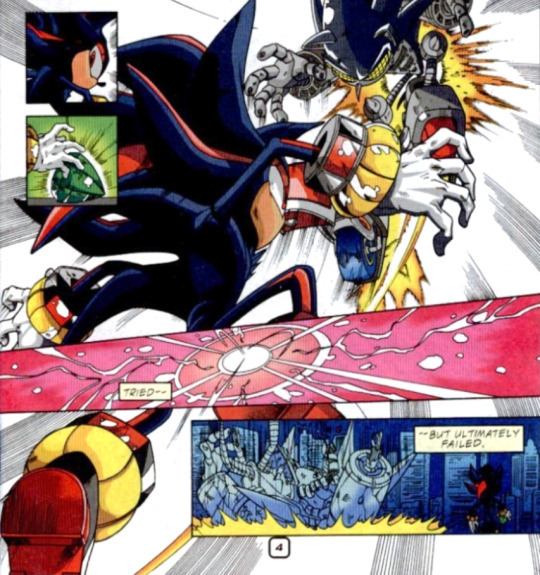
News of the theft soon reached the desk of the city's president, who mistook the figure as the hero who had defended Station Square from Chaos mere months ago, because apparently in every Sonic canon, no one can ever tell Sonic and Shadow apart, not even Sonic's best goddamn friends. Seriously, at least in the anime it's explained as being a deliberate set-up by GUN to cover their own asses regarding the Project Shadow disaster years ago. I know I've joked before about Sonic being an extremely average-looking Mobian hedgehog which is why he's so easily mistaken for other people, but seriously, Shadow and Sonic's profiles and quill style don't even look alike, let alone their fur color.
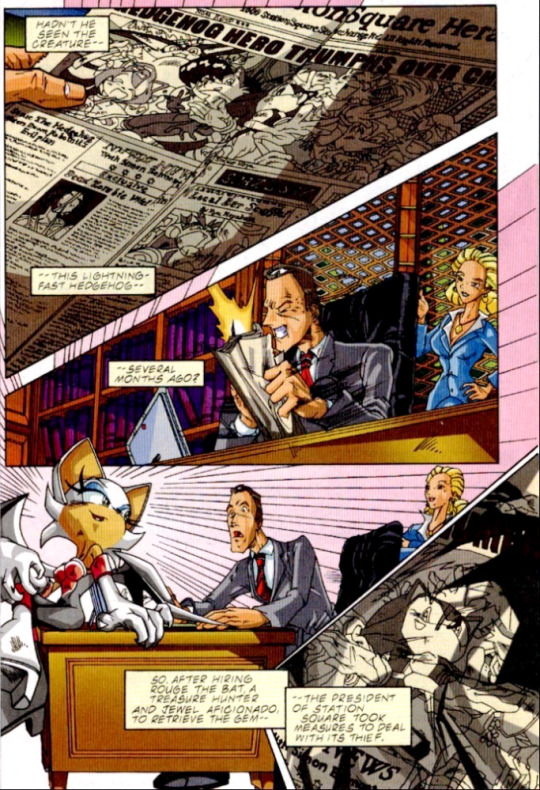
That is a very bizarre-looking Rouge. For whatever reason, they decided to draw her a lot in this era with like… claw hands, and I don't even understand where they got that from. In the game itself one of her upgrades is called "Pick Nails" and I guess you could extrapolate that to mean razor-sharp nails under her gloves that don't show up on her low-poly 3D model or something, but all her 2D art depicts her with normal-looking rounded fingertips, so I don't even know. Anyway, the comic goes on about how the president put together an elite task force to track Sonic down and arrest him for his supposed crimes, and now they've finally found him just outside Knothole. Man, if some randos from Station Square could find where Knothole was, how the hell has Eggman not figured it out yet? They pull out actual, deadly rifles and start firing wildly at him, and he dances around cheekily, stealing their guns and taunting them. This ends when they shoot an electrified net onto him, and soon he's handcuffed in the back of their helicopter, being taken to the hidden city. Of course, we know how this goes from here - he breaks free inside the 'copter and bursts out its side, peeling off a strip of metal to use as his makeshift skateboard, because even though this isn't the 90s anymore, it's still the 90s.

We're then treated to a short montage of Spaz's interpretation of City Escape - landing on the streets, surfing down sloped roads, soaping on walkway rails and leaping over any obstacles in his way. Honestly, the action is a bit hard to follow - Spaz is certainly a talented artist in many respects, but I think his decision here to move on from his somewhat simpler designs from before hurts rather than helps, as the action and lines become so chaotic that you have to really concentrate to follow what's going on. There's just a bit too much happening, so that your eyes are drawn all over the place without really focusing on a specific focal point of each image. But anyway, we all know how City Escape ends - with the iconic GUN truck chase!
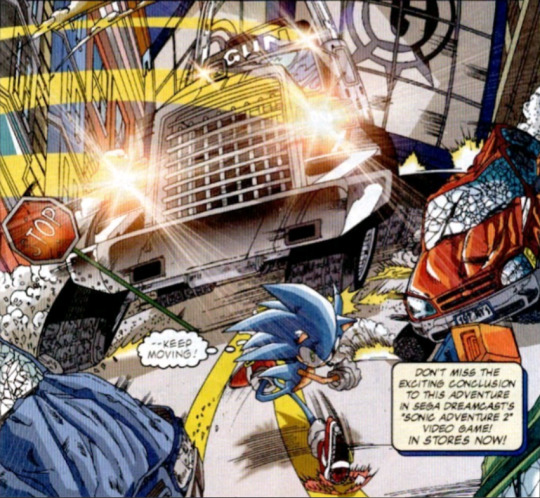
And that's… it! No, seriously, that's all we get for the actual story of SA2. The final text box invites us to play the game itself to see how it all ends, but there's a number of problems with that, the foremost being that the game takes place in an entirely different canon. We've got completely different circumstances that led up to these events. We've got characters missing - Tails still hasn't been returned to Knothole yet, Knuckles is off somewhere else struggling with his newfound powers, and humans aren't even the dominant species on the planet like they are in the game. This would leave any comic fan with a bitter taste in their mouth, as there's no actual resolution provided and no explanation for how the story will play out with so many of the original players out of commission. Many issues from now, Ian Flynn actually addressed this exact problem and gave a condensed version of events to explain exactly what we're missing, so at least we have that to look forward to in the future. There is one more story after this, and I have additional problems with that one, but let's cover the rest of the issue before I give my final opinions.
As the Shadow Awakes!
Writer: Ken Penders Pencils: Ron Lim Colors: Frank Gagliardo
So this story actually jumps us back fifty years to see Shadow's beginnings. Professor Gerald, Eggman's grandfather on his mother's side, has been working for a long time on his latest project, which he hopes will see the end of disease and untimely death and even be able to cure his granddaughter Maria's unspecified terminal illness. This project is, of course, Shadow the Hedgehog, who, as an excited and astonished Gerald watches, begins to move inside his pod. The inexplicably-brunette Maria suddenly calls him at his lab, telling him that she can see a military spaceship flying toward the ARK, their space station, and Gerald, in a panic, orders her to come to him. He knows that the military is here to take possession of his project, and believing them to be too simple-minded to understand his intentions for the project, wants to evacuate immediately. He's immediately proven right, as the military men who board the station scoff at the idea that an "old scientist and his crippled granddaughter" could pose any trouble to them as they intend to take the professor's project by force. Gerald sends Maria and Shadow, the latter now out of his pod, to evacuate in an escape pod, but of course, we know how this ends…

I think this is the only Sonic media I can think of that actually directly shows Maria dying. In both the game and the anime, the shot happens offscreen, and Shadow is ejected before Maria actually takes her last breath. I do have a problem with how the scene is portrayed here, however, as a big conflict that Shadow goes through during SA2 is his vast misinterpretation of her last request to him, whereas here she seems to just die immediately without saying another word. The military takes Gerald into custody, and shortly thereafter recovers Shadow from the escape pod, taking them both to Prison Island where they force Gerald to continue his work under their supervision. Gerald, however, is devastated at Maria's death, and thus plans out his revenge in secret under the guise of continuing his work as demanded.
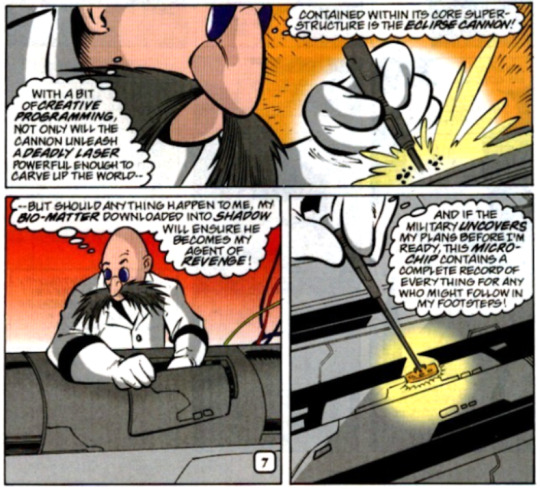
The military eventually caught on to his nefarious plans, and had Gerald executed and Shadow sealed away in suspended animation on Prison Island, where it remained undisturbed and forgotten for the next fifty years. Of course, this is what Eggman found on the island, and now he's poised to use his grandfather's own work to conquer the world. My biggest problem with this story, ultimately, is that it essentially acts as one huge spoiler for the game. Everyone now, almost twenty years on, probably knows the general gist of the story, but this comic was published when it was still very new, and this entire story basically spoils the biggest twist in the game right off the bat. Furthermore, in this story, Shadow literally wakes up, goes straight to the pod, watches Maria - who he knows nothing about - die, and then gets sealed away in his stasis pod for fifty years. There's literally no time for him to even develop a personality, let alone a relationship with Maria, which is the single most important thing in his backstory. I believe this was later retconned, but this is still a huge thing to overlook in an adaption of this game.
But anyway, yeah, that's it. That's all we get for the time being. A few brief glimpses of Shadow, and one whole cameo from Rouge. It will be a while yet before Shadow gets to make his reappearance, since like in the game, at the end of their adventure he falls from space and is subsequently believed to be dead. Honestly, the entire thing kind of gives off the impression that they felt like they had to make some kind of comic tie-in to the game, but didn't feel like interrupting what they already had going with the whole "Sonic goes to high school" thing, which is clearly far more interesting of a story. So they basically went "yeah, something like this happened, but now let's just get back to the real story." It's honestly very weird, so weird that, again, they needed a later fix-it issue to explain everything, but for now, we'll just have to move on.
#nala reads archie sonic preboot#archie sonic#archie sonic preboot#sonic the hedgehog#sth 98#writer: karl bollers#writer: ken penders#pencils: pat spaziante#pencils: ron lim#colors: pat spaziante#colors: nelson ribeiro#colors: frank gagliardo
2 notes
·
View notes
Text
Variables - fanfic ( Underswap Papyrus x Reader ) (Chapter One)
: !!: Author's notes ◌ °: !!:
﹍﹎﹍﹎﹍﹎﹍﹎﹍﹎﹍﹎﹍﹎﹍﹎﹍﹎﹍﹎﹍﹎
Hello darlings! ‧ ₊ ° “
If you don't want read the note, please, roll this part.
As I mentioned in the prologue, it's my first time doing an underswap fic, so I'd like your opinion. ˚ ˚ *
I'm doing it the way I think it would be Au if it was complete as well as the fangame, but that doesn't mean I'm 100% following its original forms. ‧ ₊ ° “
That said, I will do my best to stay faithful and make writing interesting and fun. *
The cover image was edited by me, I know it's not the best, but I tried. ° ⸼ ⊹
If I get the link or names of those who created the images I will make available. °
Remembering that I have profiles in tree communities of Undertale in pt br, if you see an Vivinare, something ( skeleton, boned or skelly) with the same post, it's me, don't be scared. ˚ ˚ *
· · ✦ · · · · · · · 1 Notices · · · · · ✦ · · · · · · ·
Fic will follow many of its original creator's ideas with some interpretations and theories of mine. Here's the link about the creator: Popcorn (His profile no longer exists, he made another and left Au, she belongs to fandom, basically)
CENSOR:
Not for fragile hearts.
CONTAINS
(in general): violence, bullying, subliminal jokes, slight depression.
GENRE:
Adventure, Drama, Comedy, Thriller & Romance
˚ ˚ * In this fanfic ⁺ ˚. *
1 Chara is a boy;
2 Has original characters.
˚ ˚ * This chapter presents ⁺ ˚. *
1 slight violence;
2 Citation to depression;
3 drama.
Attention:
Big chapter ahead.
﹍﹎﹍﹎﹍﹎﹍﹎﹍﹎﹍﹎﹍﹎﹍﹎﹍﹎﹍﹎﹍﹎ ﹍﹎﹍﹎﹍﹎﹍﹎﹍﹎﹍﹎﹍ A year has passed… No news ... No trail ... not even false leads. (That fill us with hope just to take care of us.)
We.
I haven't used those words in so many days when referring to my life. Just one in the back, my brother was kidnapped. Chara was taken from me and taken where no one can find him. Your friends' parents shout accusations, as if I could hurt a single hair on your head:
"- It was certainly the oldest. After all, it's not the first death of the family. -"
Heh. People can be cruel.
We were four. He, the only boy and middle brother, only ten years old. The other oldest, Bianca, and the youngest, Daisy, were murdered by someone we trusted. Bianca's boyfriend, Elric, was on the Wizards Order. And to be accepted, the fire had to be fed with a precious commodity. He spent years fooling us into doing this… so that I could do that to him… That was two years ago. I tried to overcome my sadness, Elric was already under arrest, there was a Chara to be comforted. Gradually, our somewhat lonely new routine took shape. He made good friends who didn't judge him as many citizens: relatives of the children killed by the weirdo. Affectionate surname. We finally started to straighten up ... Until one day a couple broke into the house, terrified Doug, Chara's best friend, while frantically attacking me and the other taking my brother out of me in the blink of an eye. Despite my success in containing who attacked us, the other simply disappeared without a trace ...
It was like magic.
The search began in a human pursuit. All in vain. Police dropped the case in the fourth month, new ones were emerging. And there's no way to blame them for that (in a small, old town near the mountains, Ebottown had its high dose of violence.) The neighborhood avoided me as if infected with the plague and made a point of emphasizing how much I was despised. Escape, death. I thought of all this. But the spark of hope that he could come back kept me from leaving. And for that, I tolerate. All the antagonistic attitude of the neighborhood took me from my daily work. It just wasn't working, and my colleagues got angry every time my presence disturbed their eyes. To ensure basic survival, I accepted the night job offered by Luka, (The intimidating woman, the neighbor of the front house. Tall and powerful, with flawless black skin. Wearing her full hair or brightly colored turban, but there was always a vibrant purple, almost neon. His style of clothing was almost Gothic, spiders reminded me, for a strange reason.). The job was in a very elegant night bar serving colorful drinks and a space for parties or 'dances'. All the darkness and the bright alcohol made it difficult for people to recognize me, and anyone who dared to bother me was quickly arrested by the other bartenders or Luka, who was responsible for security. Strange to say that I felt more comfortable there than in my own home… loneliness ails me. Like now, a rainy day, with strong winds. Typical of the city. Interestingly on my day off. No strolling around, (Y/N).
* The rain outside is cold as your feelings and you know you don't deserve it.
A sigh and a roll of his eyes. I was annoyed myself. This whole situation, as if childhood turbulence was no longer enough, made the most frequent episodes of self-deprecation. Now it wasn't just my huge thighs or scars until I said enough. Or having tires in place of a perfect waist, or my abdomen getting easily swollen. No ... That's what I said, how I said it, how I breathed ... I probably needed help:
* But no one will come ...
I got. Luka was a good person, but I couldn't pour that much on her�� I'm not worth it. With a flick of my tongue, I got up from the flowered carpet, centered in a bedroom entrance. I just went in there to clean, other than that, I watched the empty beds by the entrance, in silence. I closed the door carefully, looking back out of habit before going to the bathroom. A few gray floors peeled off the wall (cheap workmanship), the sink still full, but there were leaks in the pipe, the toilet was so bad it clogged up with the urine flush, the boxing was tiny, as if someone was trapping you in the closet while bathing you in cold water. Yes, the shower burned. At least I still have cute cabinets and a mirror….
Ah…
I looked into the mirror.
* After all, it's still you.
Long, curly hair, very messy and (h/c), with all the broken hair floating around (better known as fritz and he was too thin to be soft), reddish brown eyes (which weren't as red as Chara's) were probably the only things I liked about myself. Then we have my skin (s/c) very pale due to lack of sun exposure, random acne spreading, not in excess but bothering, deep dark circles, decorated with today's tear marks. A humorless laugh escaped my lips, his hand moving almost on its own, turning on the tap, rubbing the water over his face carefully. This is kind of dangerous, being alone with my sad thoughts.
" Finally. " I sighed, wiping my face on the nearest towel, hands then, as a painful smile crossed my face. " I have that." I tapped my side pocket of shorts where a deck of cards accompanied me everywhere.
It was like an extra part of me since Luka gave it to me, along with three other never-missing items: the black lipstick that Bianca wore when she came out with us, always in a pocket, the yellow ribbon of Daisy's hair on my head. her hair may look like a rattlesnake's nest, but she was always there.) and the weird book of basic flirtations that featured Chara as a pun and that he liked more than necessary (though small, no longer fit into pockets, so the his usual place next to my hip, between underwear and skin.)
I took advantage and wet my hair a little, as if he wasn't coming back to it later. Finishing up and getting some of the apparent melancholy from my face, I managed a hesitant smile at my reflection, but it returned to the cold look when something seemed to burst in the distance and the light went out. A blackout… when all I have to eat is frozen spaghetti and I'm out of gas.
So ... so ... perfect.
Worthy of a rainy day, which seemed to get stronger by the moment. Making a loud, unfamiliar sound, I emerged from the bathroom downstairs, using instincts to move without breaking anything. A kind of mind map danced in my mind, the matches in the cutlery and candles in the open closet seemed to light up like object-hunting games. I lit three candles that had already been used, then looked at the plate of food waiting to be warmed. Shaking my head gently, I put it in the fridge, even though it had no light to keep it intact, and pulled a jar of yogurt in place. This will be my dinner. Sitting at the round table with a prepared spoon, I began setting up the cards to play solitaire when I heard another noise. Much closer than the last. Slowly I took the cards from the table and stuffed them in my pocket, frowning.
A bang ... Coming from the room. Walking carefully, I approached, looking slowly out the door. My coffee table was split in half, the iron baseball bat stuck in the wood seemed to be the murder weapon. That stick was from Luka ...
More noise came from upstairs, my door still seemed to be closed. A kind of cold rose in my veins. This was strangely familiar. I looked around the room before going to the club and pulling it carefully.
* The Metal gave you a shiver of premonition.
I climbed the stairs, knowing exactly where to step so as not to make noise, but when I reached the top floor, I relaxed. The noise ceased. All doors remained closed, my room being the only exception. I peered through the door and, as I thought, he fled, as he had a year ago. The room was ruined, as if it had been a break-in party. The bed broke, the mattress was torn, as were my papers and the wardrobe on the floor, some scattered clothes, a strange substance staining the rug and writing on the wall: - You know where to find me. - My camping backpack, which I used during the research, and a book on the history of the city were in the center of the room. The open book, an image of Mount Ebott circulated there.
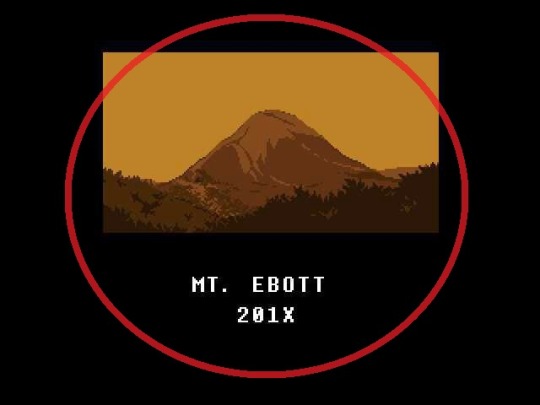
"... All right, all right. "
I grabbed the backpack and the book, going down and putting on my neon blue wellies before leaving. I looked at Luka's house and the staff in hand, then ran, just pushing open the door. I didn't have to walk much, she was in the middle of the room, which had several broken things. Concerned, I knelt beside her, almost panicked, but relieved when I saw her breathing. I used your phone to call the police, but decided not to wait. Finally, I have a clue. A chance to catch him. I needed to do this. I laid her on the couch and left a small note, leaving before I changed my mind.
* You are full of justice.

It was night when I started to cross the forest. The rain persisted above, making the cold run down my back. Sharp branches and thorns scraped my skin and ripped my clothes, but now I barely cared. I needed to continue. It wasn't long before I reached the clearing in front of the mountain, the place that started it all. Immaculate gray dust lay where the eternal fire lay. Not washed by rain, not carried by wind. Right there, waiting. I wiped something hot from my face and turned, the cock getting colder against my skin.
* You need to move on.
Gradually, I felt scratches burning, but I made sure they wouldn't be long enough to stop bleeding. As expected, climbing was not an easy task. The soaked, sloping ground was almost a waterfall of mud that made me slip and lose my balance as I stepped on the loose rocks. My hair, my legs, my clothes had mud on everything. I dropped to my knees as I reached one of the peaks, breathing hard as I looked into the dark cavern not far away. Lightning roused me from the trance I entered, so I started to get up, feeling someone watching me.
- It is not bad. -
With one hard blow, I tried to hit him behind me, a whistling noise was all I could get. My muscles tensed automatically with the evil laugh. " Not bad. " He sneered behind me again, his dark red cloak flapping violently in the wind, mocking his hands saluting me.
" What you want? " I growled. He started to laugh, part of his mouth visible, a large scar on the left side of his face, lips and chin. " Foolish child. You have no idea what you did when you attacked that wizard, do you? Knights are so ignorant. " He shook his head, like I was a lost cause. A gold stick with a ruby top appeared in his left hand. " So we agreed that you should be eradicated, like monsters. But you multiply like rabbits." His voice was thoughtful. " Anyway, it's trivial in our day ... But, how you attacked us ... A massacre is inevitable! " Another laugh followed.
* You have no idea what he is talking about, but decide to face him anyway.
" Does not matter. " I took a deep breath, making a decision. "I don't want to know your motives now." I watched the ruby light up with its magic. " Still ... You must be punished. "
With a speed I didn't know, I advanced and hit the club in his ribs, pushing it aside and giving him a breathlessness. A sigh of pain was all I heard before something moved away from him and fell to the muddy ground. I felt discomfort in my chest and arm, but got up without difficulty. Once again, I set off to attack, but dodging a red sphere he threw. It surprised me and the rodeo was not so successful, it scraped my arm and burned my skin. Others came and it was hard to get rid of them, the mud at my feet making me slip all the time. Adrenaline took over my body and I felt even faster, confident, almost enjoying fighting, the steady pace: side, side, spin, jump, run, roll, attack, lose. It wasn't long before I hit his face, an uncomfortable, muffled sound sounded around us, something that looked like a tooth flew away from him. He withdrew closer to the cave, making me follow him cautiously. That smile sent mixed emotions in my core. Suddenly, many spheres formed and advanced against me at high speed, barely leaving room for evasion. One of them hit me in the belly and the pain I felt was masked by the lack of mobility. No matter how much I moved, I couldn't leave the place.
" Finally. " He hardly seemed to have such a hoarse voice that he seemed. " You slippery trash. " He approached, holding his stomach, sweat mixed with rain, some blood dripping from the corner of his mouth. " Now. " He gripped my face tightly, the team being torn from me and thrown into some dark corner. " Come . " My body began to float, following it to the cave. " Com'on, not look at me like that. I'll tell you a secret. " He laughed. It wasn't too deep, there were flowers scattered all over the floor, all golden flowers, I think, a smaller hole in the ceiling where the rain fell and a larger, very dark hole in the floor. On the walls, several inlaid crystals gave the lighting a mystical feel. Suddenly I was hurled, slipping on the floor and ruining some flowers, stopping right at the edge of the hole. Barely able to move, I lifted my face to face him. I was completely defenseless. There was a macabre smile on his face, his now visible eyes glowing with blood red. "Your brother is just waiting." He whispered. " Go get him. -" And a kick threw me in my death. Soon, only darkness painted my world.
*It's the end.
· · · · · · · · · · · · · End notes
My english is very beginner, so i'm using the help of google translator. If anyone with available time can help me review, I appreciate it. (Y/N) - your name (h/c) - hair color (s/c) - skin color More legends will be added in the future! Word Count: About 2,880 If i use any images similar to the game can be found on the Gamejolt website. They do not belong to me.
#undertale#underswap#undertale au#reader#fanfic#neutral route#chara dreemurr#mages#magic#underswap x reader#swap papyrus x reader#swap papyrus
3 notes
·
View notes
Text
The Bold Type 3x09 “Final Push” and 3x10 (Finale) “Breaking Through the Noise” Review
Before I say anything — they put “Wasabi” by Little Mix on the soundtrack for the finale. Please, everyone, do yourself a favor and start listening to Little Mix. That is all.
Welcome to the last two episodes of The Bold Type Season 3! I’ll confess that due to traveling, work, and being in a wedding I’m getting this out late, so I figured I’d do a joint review. It wasn’t that difficult to manage, honestly: with these two episodes being the penultimate and the finale, they certainly have the same themes and conflicts driving them. Let’s start with 3x09, “Final Push.”
At face value, the title could be interpreted as a “final push” for the season, but the episode also sees our core three each have a “final push” of their own, the cumulation of a season of storytelling.
Kat’s “push” is both the end of the election and the mounting pressure to decide between Adena and Tia. Pressure is certainly mounting for her campaign, and she’s just starting to realize what this means for her time at Scarlet — sure, she has big plans if she’s elected, but gaining a council seat would mean not working at Scarlet anymore. Patrick certainly isn’t helping by forwarding her options for her replacement, and seeing Adena didn’t make her choice between her and Tia any less complicated.
Much like Kat, Jane is being “pushed” both professionally and personally — she’s struggling at a time when she should be thriving. Pinstripe is still on his book tour, getting on her nerves every time he gives an interview where he puts on the playboy act, not unlike the main character in his book. Her Pamela Dolan story with Jacqueline has the potential to be a career defining, groundbreaking piece, but she’s dealt a huge blow when Jacqueline is forced to give the story over to Patrick at the dotcom. Apparently Pamela Dolan, as soon as she was informed of the Scarlet story, decided to launch her own version at another magazine. If they had any hope left of publishing first, they couldn’t wait for the fall issue. The only way to publish would be on the dotcom, still making a splash but handing Patrick most of the influence.
Next is Sutton, who is…putting on a fashion show? I guess that would be considered a push, since apparently an influential designer will be there and this could be the start of a potentially successful career for her.
I want to be able to write more about Sutton — she’s doing well, she’s happy, but her story lacks oomf. She’s not getting the complex storylines that Jane and Kat are. Sure, her and Richard have had the occasional conflict or misunderstanding, but that and her foray into a design seminar (which we’ve barely seen) are the only things they’ve given the incredibly gifted Meghann Fahy to work with. They did give her a moment with Carly after she opened up to Sutton about how insecure she feels when compared to the models at Scarlet and the girls on instagram, but it fell flat.
Her side story with Carly this episode did little to improve Sutton’s lack of depth; it seemed like an afterthought when the show suddenly remembered they needed to give Sutton some kind of inspiration for her designs. It is pretty on-brand for The Bold Type to touch upon body image, but it came on too quickly and from a character that doesn’t have a lot of influence (sorry, Carly, you’re still adorable). Sutton is supposedly not good with children and hardly even knows Carly, but she manages to get her to open up about her insecurities and gives her a touching speech nonetheless. To say this seems forced would be an understatement.
The very end of the episode is perhaps the final “push” for everyone — in the closing minutes we find out that Richard got a job offer in San Francisco, Ryan returns to tell Jane he kissed someone else, and Kat loses the election. Seriously — if you shut off the episode one second before the ending you would have missed it.
Alyssa’s episode rating: 🐝🐝🐝.5
That leaves the finale to pull everything together, to help our core three “break through the noise.” (See what I did there?) The problem is, while this was a good episode, no one actually broke through any of the noise that the previous episode created. It certainly created more noise by the end, leaving everyone on a massive, show-changing cliff hanger.
A prime example of this was Sutton’s sudden change of heart — the fashion show she put on was nice, and everyone looked great. The message was there, and despite the quick decision of adding Carly to the mix, it was still really touching to see Carly being able to watch everyday women in the fashion show.
Sidebar one — I’ve never liked when people say “REAL women should be in fashion shows, not models.” I get what they’re saying, I really do, but REAL women come in all shapes and sizes, including skinny. Please don’t take that to mean that skinny women face the same hardships that other women face, because they don’t, but I think we need to remember that there are people who are naturally skinny. I like the term “everyday” women much better, since that implies that fashion models don’t represent women that aren’t, well, fashion models. Anyway, moving on.
I will say (sorry, Sutton), the fashion was not good. I really hoped that they’d spend a little more time developing Sutton’s style; it would be a lot more convincing to see her as passionate if her work had a little more pizazz to it. Instead it ended up looking like the outfits of a 1970’s American Girl Doll (again, sorry Sutton).
Sidebar two — can The Bold Type make it so I don’t have to apologize to Sutton all the time? It’s exhausting. Work on that, please.
All of this, only for Sutton to realize she didn’t want to be a designer. Now, that I’m fine with — but leaving that for the finale was pretty lackluster, the result being a bit of a wasted season if Sutton was going to end up right where she began, kind of like Jon Snow back at the Wall (don’t @ me). If they wanted Sutton to explore design and in doing so discover it wasn’t for her, that’s fine, but keeping that to a half season arc would have been much better.
The build up for Jacqueline and Jane’s Pamela Dolan story also resulted in a bit of a let down — giving the story to the dotcom certainly made sense for the story, but not for the show. After a season of buildup, which I was pretty excited about, the story was published pretty unceremoniously. Jane’s dealing with Pinstripe was also a bit of a bore. I’ve maintained that I think that Jane and Pinstripe are good together, but we only see that when they’re amicable. When they’re fighting there isn’t any romantic angst, and if Pinstripe were to take off I don’t think he’d be missed. Compare that with Adena, whose presence was definitely missed after her breakup with Kat.
My point is, just because I supported Jane choosing Pinstripe over Dr. Ben (ugh, remember that guy?) doesn’t mean the show has done the job of convincing me that Jane and Pinstripe are or should be endgame. Jane ends up going back with him, adamant that he has zero chances left, and they end in a really sad place. They admit they love each other, but I didn’t read that as a victory. It sort of read like an unfortunate fact — I love you, so I guess I have to give you another chance. Maybe Katie Stevens did too good of a job acting devastated.
Everything sort of builds up, only to end in a disappointing drop off. For Kat, we see her deal with the loss of the election (bravo, Aisha Dee). I will say that I expected the loss — it would be a little too idealistic to give Kat a win, in my opinion, but the real reason for my expectation of loss was The Bold Type’s tendency to push characters out of their comfort zone only to pull them back again. It seems, much like Jane’s Incite and freelance storyline in Season 2, that no one can really be gone from Scarlet for too long. Much like her election story, Kat is hanging in limbo with Adena and Tia after deciding that she isn’t choosing anyone for now, and is instead going to focus on herself. This on its own isn’t disappointing, but combined with everything else that’s falling short, it contributes to the dragging down of the episode.
Now, for the comfort zone point I made earlier — it seems like that is where this bummer of an episode is coming from. If Kat won, she’d have to quit Scarlet. If Sutton wanted to continue designing, she’d probably have to make some moves and go to fashion school and/or seriously cut back her time at Scarlet. If the Pamela Dolan story had more punch, maybe it would have catapulted Jane’s career and send her to bigger and better things outside of Scarlet.
Despite The Bold Type being a great show, accuracy has never been a strong point. I don’t think anyone whose worked at a magazine or in journalism in general can look at this show and think “oh yeah, it’s just like that.” Keeping Scarlet at the center isn’t the mistake, it’s how they maintain it. We’ve seen all three of the girls take giant steps forward only to fall back on Scarlet, and it’s happened so many times that it’s a let down. It’s certainly possible to keep Scarlet around and let these characters grow, but it seems like The Bold Type hasn’t found that method quite yet. However, that giant cliffhanger might foreshadow some branching out at least — Scarlet is done, presumably shut down, and it’s not clear to me how they’ll manage to get it back.
Of course, most of that has to do with how little we know about the situation — was it the Pamela Dolan story? It doesn’t make much sense to shut down a whole publication over a very popular article. Was it Jacqueline revamping the fall issue to be all inclusive? It would have been easier for them to fire Jacqueline in that case, and they DID just hire Adena has the in house photographer the night before, so clearly HR knew nothing. If either of those are the reason the magazine is shut down, it could easily be turned into a “Scarlet is a martyr for inclusivity and inconvenient journalism” story.
Even if it’s (and it is, most likely) temporary, I think The Bold Type needs to make the world of Scarlet a little more harsh in order to make it more realistic, and not use the magazine as a crutch that the girls all lean back on. As soon as that happens, they could have their best season yet.
Alyssa’s episode rating: 🐝🐝🐝.5
The Bold Type has been renewed for a Season 4, premiere date TBD, with Wendy Straker Hauser replacing Amanda Lasher as showrunner.
1 note
·
View note
Note
How would you describe each of the Rammstein members to someone who knew nothing about them?
Oh man… If we’re being honest, you don’t really start with the juicy bits (that keep making people come for more) if it’s someone who really doesn’t know anything about them. But I will try to make this as newbie-friendly as possible, and add enough simple details to maybe explain the level of fanatic adoration for them. (But I must admit that 1- this will be loooong as fuck and 2- I fangirl about them for their professionalism, so it won’t be as humorous as one might hope)
I’ll do a collection of posts later throughout the week tagged “Rammstein glossary” about each member, maybe get other blogs on board, but I’ll keep this exclusively newbie friendly, if a tad bit too long
Ok, so, first things first. Facts you can gleam from any wikipedia, with a little introduction on the side.
There are 6 members of the band:
Till Lindemann - the singer, the poet and a professional pyromaniac
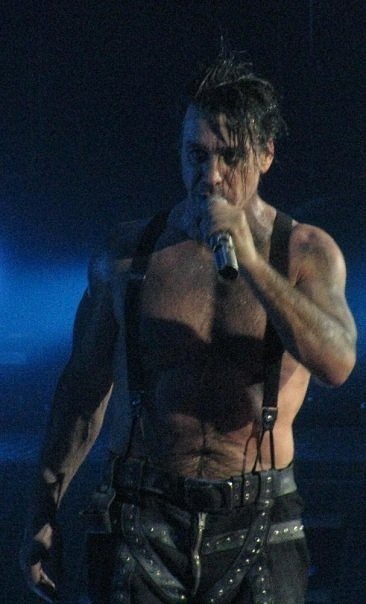
He’s an intimidating man, with tall frame and a build of a panzer tank. Till commands the stage with incredibly rich baritone voice and penchant for being set on fire, or carrying big ass flame throwers.
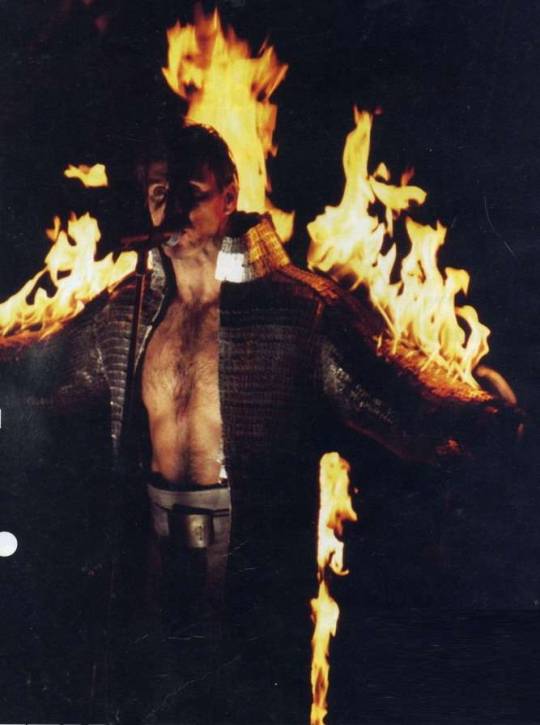
Matter of fact is he’s shy, introverted, doesn’t like being stared at (hence the fire, to distract from his form) and is a soft spoken, polite man - also, his speaking voice is much much softer and gentler. People generally find him fascinating for this paradoxical character.
Richard Z. Kruspe - the guitarist and founder of Rammstein

He is..how do I put this? The typical artist. Diva and control freak, plagued by doubt and striving for perfection, which all make for one hard man to work with. Richard is somewhat of a Tumblr’s sweetheart. He’s aware of those traits, and the most talkative of the group - especially about his mental health, and the problems he faced. Which means people often relate to him, and he’s genuinely a kind and engaging conversationalist, so there are a lot of his interviews to be found online.
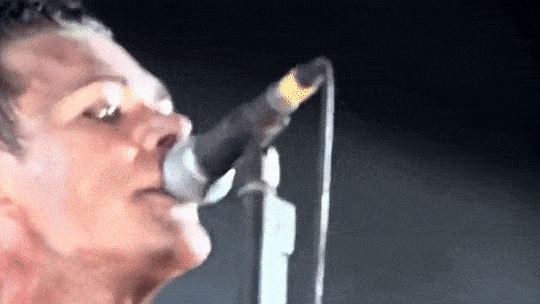
Also, it helps that he’s easy on the eyes, let’s be real. Also, he’s a natural meme inducer. Everything that man does and say is meme-able as shit.
Paul Landers - the other guitarist
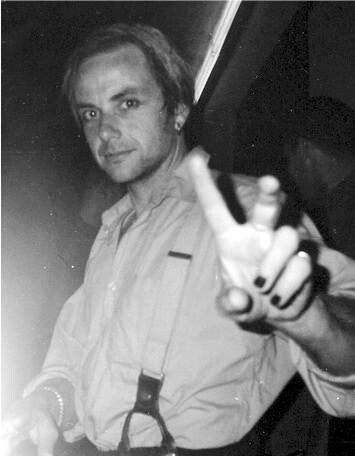
Always smiling and extraordinarily exuberant, he’s seen as the most approachable and somewhat of a goofball of the group, always up to some antics in the background. He’s the shortest and openly the silliest of the group, so Paul does sometimes get a bit.. infantilized by some fans.
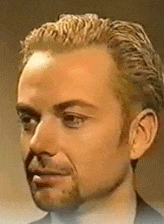
He’s got an unexpectedly rich singing voice, and he’s probably a bit of a control freak himself. For a guy that talks a lot, he doesn’t share personal details as often as Richard, so he’s also somewhat of an unexplored entity. He used to be in a previously successful punk band “Feeling B” with Flake
Christian “Flake” (fla-keh) Lorenz - the keyboardist
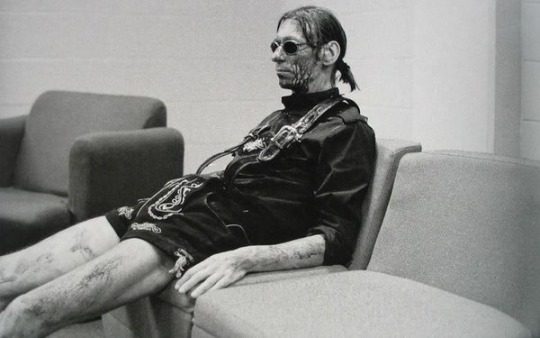
This is all you need to know about him. Joking. He’s extremely tall, lanky and born with a soul of a cranky old man. He was with Paul in the previously mentioned band.
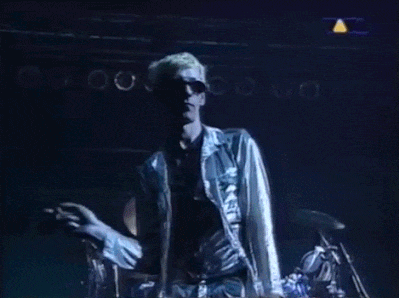
He’s.. how do I describe him.. I think he’s the only member you have to go anecdotal to explain him. When they play live, he has a treadmill that he paces on during the entire concert because he gets bored easily. Flake has this sort of… interpretive giraffe-being-tazed-by-electric-fence dance that he does. He’s …somehow he’s the craziest of the group, I really have no vanilla explanation for him. If you get into Rammstein, you’ll get it.
Oliver Riedel - bassist
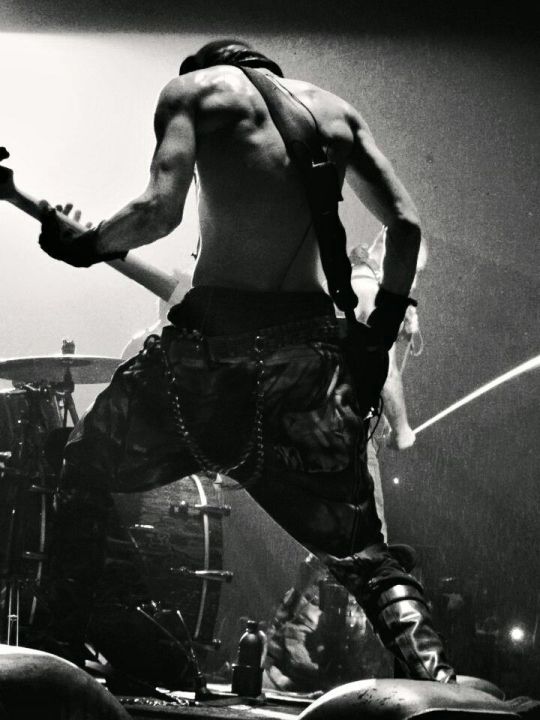
True to the stereotype about bassists, he’s tall as fuck, quiet and people forget he exists most of the time. Ollie is the youngest of them all, extremely private, and generally a sweetheart. There really isn’t a lot to be said about him - he’s the outdoors-y, athletic type and he also joins in on Paul and Schneider’s antics.

That’s how you do proper crowd surfing
Christoph “Doom” Schneider - the drummer
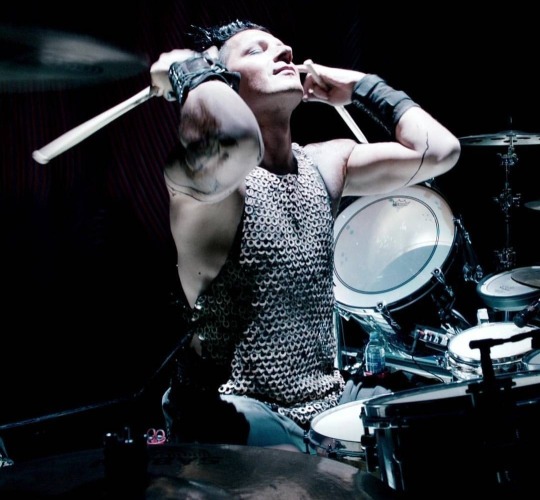
The sassiest of the bunch. I would categorize him as an extrovert, but a very well contained one. He prefers being called by his last name, though the Doom nickname came from the time he needed a name for the German copyright agency (Christoph Schneider is like John Smith of Germany), and he was suggested by Paul to use Doom, because they like the game. Incredibly confident, but also quite silly man.
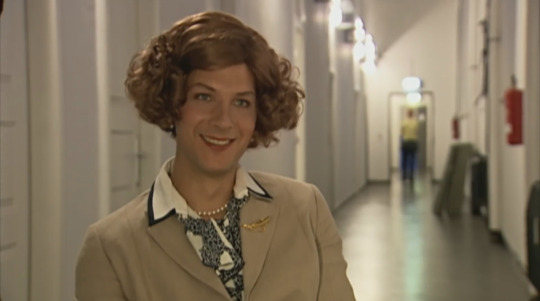
In one video, he was dressed as a woman - often referred to as Frau Schneider - and he did it so well (uptight mannerisms, pursed lips, sitting posture that would bring Petunia Dudley to tears all packed in a shockingly beautiful face - I mean, look at him!) that it’s now a part of the live show for him to appear with make up and a wig.
Now, the band, Rammstein.Let’s skip the things you’ll find out from a quick read through of wikipedia, like the name, when they were founded, and all that, instead let’s go for:
What genre are they even?
What songs would you recommend a first time listener?
Why are they so well liked?
What’s so special about them?
The debate about the genre is still on going. You have people claiming they are metal band, you got the German Neue Deutsche Härte genre, you got… tons. Best way to describe, if you want to go for a solid genre label, is Alternative Hard Rock - because they are not really a metal band. But if you’re aiming for the heart of it, it’s Industrial. It’s “abrasive and aggressive fusion of rock and electronic music, with a side dash of punk”. More on their style later.
For a newbie, you got different types:
Not a fan of metal or hard rock at all - If you want to go for easier sounds, where Till’s vocal’s are more prominent, and the instruments are not as aggressively in your face, I recommend Amour for an easy introduction to his vocal style, Ohne Dich, Rosenrot and then Seemann and Mutter
Preferes rock to metal - Amerika, Mein Land, Ich Will
Fine with metal, but generally sticks to upbeat songs - Ich Tu Dir Weh, Weisses Fleisch, Haifisch and Du Riechst So Gut
Open to metal, but prefers the gothic or more alternative genres - Mein Herz Brennt, Engel, Rammstein
Metal (take it with a grain of salt, not everyone would call it metal, but the sound is hardest in these) - Mann Gegen Mann, Mein Teil and …Benzin? hesitant on the last one
Of course, this is purely my suggestion, and some won’t agree with this classification, but I think it’s a solid introduction to them. Also if you can convince a friend not to watch the video until they hear the song first, I think that would make it somewhat easier to get them into it (because hey, you made them listen to it twice, and they are watching a video so not as focused and they’ll get int— is it obvious that I forced 3 friends to do exactly that and that’s how I got them all into Rammstein?)
This is getting so long at this point, I am putting more effort into this than into my college essays..Why are they so well liked? In short: Fire, Professionalism, Democracy, Music and Controversy1) Fire. “Other bands play, Rammstein burns!“
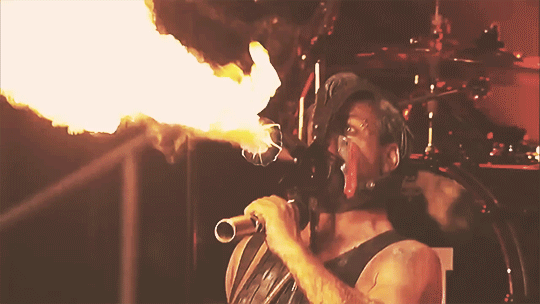
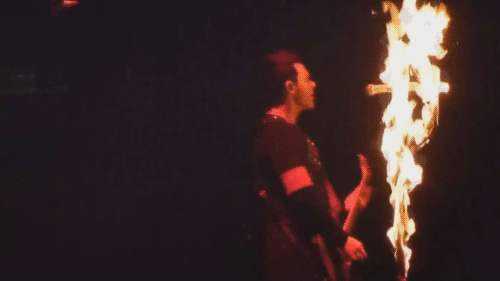
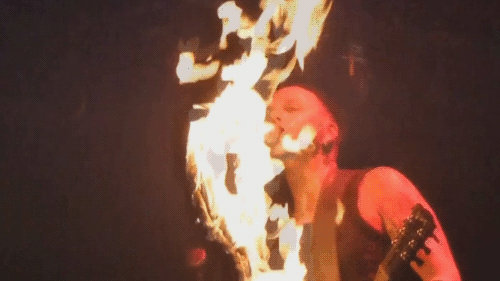
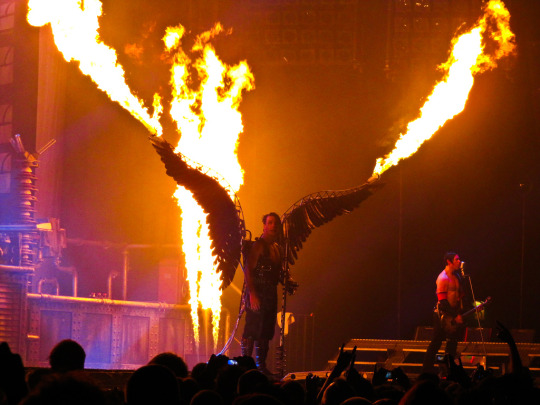
Ok, not just fire. Though it’s pretty cool.
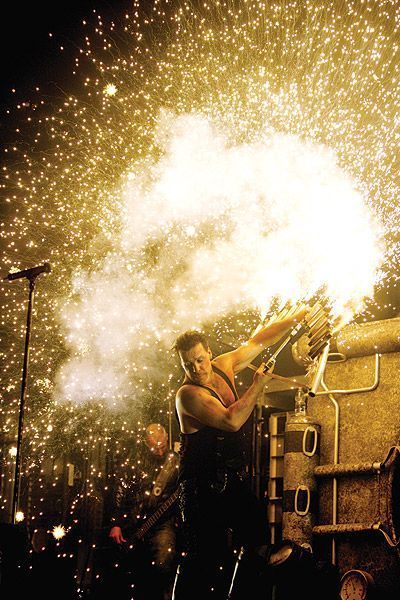
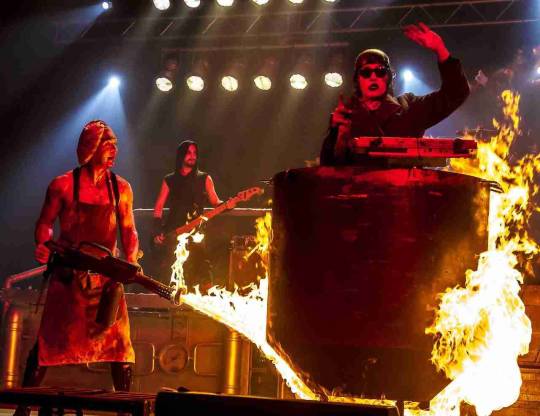
2) The ultimate professionalism. I am not kidding when I say that giant, well planned Broadway Musicals pale in comparison to the sheer perfection and amount of panache they put in their live gigs.
It’s considered that it should be on everyone’s bucket list to see Rammstein live at least once.
I don’t want to stereotype Germans and working like machines, but what makes Rammstein so good, is that they really stick to that stereotype where everything is a perfectly executed machine with no space for fucking around.
3) Democracy. This influences the professionalism part in the sense that, since all the members of the band have an equal amount of vote over what gets done and how, it means that they all criticize each other’s ideas until they find the middle ground. That middle ground is how they kept their specific genre, while managing to churn out wonderful after wonderful album (I am being very biased here, I just really like every single album, all for different reasons), all with a firm idea of what Rammstein is for all of them
4) Lyrics
First of all, about the lyrics - they are all written by Till. Yet on all songs, credits go to all the members, because everyone gets an input. It really cannot be understated how much of a group project this is. It’s a democratic band where everyone holds the same weight.
My personal favourite ones are Dalai Lama and Klavier. I am sucker for story telling songs and the words he uses are so perfectly chosen! The first one is a twist on Goethe’s poem while the second one is a very dark love song.
5) Controversy
Since this has gotten embarrassingly long, let me say this in shortest way possible: Some people like provocative, others abhor it and together when they argue they market Rammstein like no other. Rammstein has been blamed like any other metal band for school shootings, Nazi imagery, promoting physically abusive relationships, inciting youths to unlawful/harmful behavior etc. while doing none of that.
But in general, Rammstein has a wonderful attitude of “Interpret out lyrics anyway you want to, we just draw the line at being called Nazis.” and they usually make a point of just telling a story/ presenting a song whose lyrics and/or video are but an element to the entire thing.
Oh my god, I finally scrolled up to check if I answered everything, and you didn’t even ask for all the rest, I just kept spewing on and on D:Sorry!Once I start about Rammstein, I keep going on and on and on. I hope that at least was a good enough introduction, I’ll do those little glossaries with in jokes and fun facts later, as I promised all the way at the beginning
27 notes
·
View notes
Text
Japanese Horror Critical Reception
Japanese Horror films gained lots of recognition and popularity starting in the early 1990’s and going until the end of the 2000’s. It was categorized as the J-Horror boom and soon enough after seeing the success the genre was generating, it made its way overseas to America, where lots of films were remade with bigger budgets. J-Horror set itself apart from the films that would be categorized as “scary” at the time. What made the movies created to fit this genre different was the removal of the more gory and slasher-style, rather shifting their focus to physiological thrilling. It builds the tension and suspense as the film goes on with the use of supernatural horror, which is usually ghosts. The spirits that come to haunt the characters are usually vengeful, meaning they were provoked sometime before, and are linked to objects that are commonly used by everyone in the audience, for example a TV or a phone, as you cans below along with a more in depth breakdown of what J-Horror is:

youtube
The films that will be expanded further in this blog are Ju-On:The Curse, 1 and 2, (2000) and (2001) and Ju-On:The Grudge (2002). See the list of every Ju-On movie below:
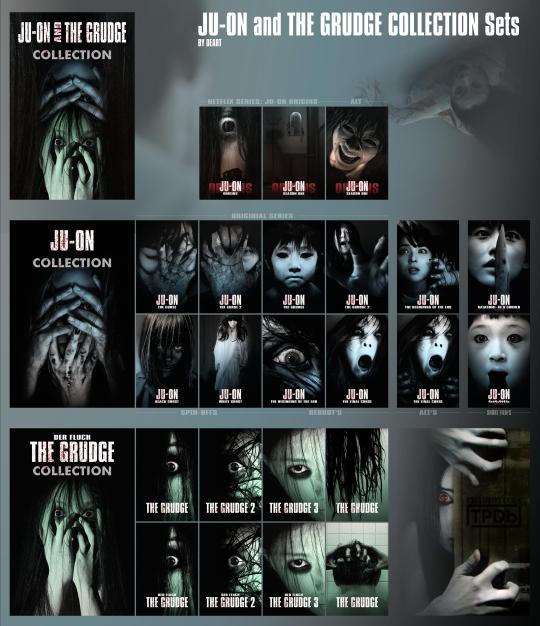
In this blog, we will be looking into the critiques of the first installment of the Ju-On series and how they were evaluated and adjusted to in the next film.
Ju-On:The Curse is divided into six parts that are in non-chronological order, however, are all connected. They all focus on a cursed house where a man murdered his wife due to a jealous rage.
In order to understand the film, I had to search what Ju-On was and how it works, coming across this description: “According to Ju-On, when a person dies with a deep and powerful rage, a curse is born. The curse gathers in the place where that person has died or where they were frequently at, and repeats itself there.”

The sequel and second installment of the series does a lot of retelling of the previous film then gets into greater detail on the events that transpired before. Both films follow this confusing non-sequential order where the first story that is shown could really take place after the fourth story or the sixth story shown could really be the first story. It is even more complex just trying to explain it.
The evaluations of the two films by critics with a more reputable background than I matched exactly how I interpreted the film. Although the film is very creepy, a lot of my time was spent trying to figure out what was going on, rather than the psychological aspects of the horror. Part of the confusion for me could come from my lack of understanding of Japanese culture, but to many, including myself, the non-chronological order throws us for a loop. To better this style of film, see the image below:

Maybe I am just lazy and want everything laid out in front of me to be easily interpreted, but this is what makes the Ju-On series unique, so in the end I see this as a positive. Some critics wanted away with this technique used by director Takashi Shimizu, however, it makes his films stand out compared to the rest. The audience has to put the pieces together in their head, kind of like solving a mystery. Great films make you think, like this one. See an interview of Shimizu talking about The Grudge below:
youtube
I would say these films are not for a casual movie watcher like I am. I would prefer a linear formed plot but the more I read about others opinions, Shimizu perfected the technique of engaging his audience and making sure everyone is paying attention for the entirety of the film.
Now looking at Ju-On:The Curse, from a negative evaluation and how it was improved upon in Ju-On:The Grudge. The goal of the earlier film was to end on sort of a cliff hanger and get people excited about the new one that would be coming out soon. Saying this, with how good the movie was up until that point, it should not have concluded the way it did. One of the characters, Kyoko, is shown in the closing moments running away afraid because she sees a ghost-like figure of a woman in the window. Just not an exciting way to finish the film, luckily, in The Grudge, Shimizu gave us a way better ending. See image of the woman in the window and a breakdown of the ending below:
youtube

Sources:
Introduction to Japanese Horror Film, Cole Balmain
Devils Advocates, Ju-On: The Grudge, Marisa C. Hayes
0 notes
Note
So in my story, there's a torturer that tortured the main character enough to leave the protagonist with some decent mental and physical scarring. He had a plan and reasons for doing what he did, but the plan was formed out of anger for the organization she works for. The protag originally knew him well and did trust him, so it was surprising to everyone that he'd do something like this to her. It takes a lot of care to get the protag back to a point where she can so much as think about him. 1
But later on during a fight between the two, the victim and torturer get in a situation where the victim ends up saving her tormenter from a fate worse than death, not because she forgives him or anything like that, but ONLY because she's not a vengeful person and the terrible fate he would have met was not something she wanted for anybody at all, which happened to include him. My question is, how can I portray the villain well after this? I plan to have him quit scheming against the protag, 2and even help them in some ways from the shadows, not apologizing, but also not interacting with them, or anything redemptive like that. I'm not trying to "rehabilitate" and "reintegrate" him into society, but I want the fact that he was saved by someone who could've had free revenge on him instead saving him to leave a profound impact on him. How can I show this without making it look like a heel-to-face turn and not making it look like I'm trying to make him sympathetic or "good?" 3
That’s a very interesting question and scenario. It’s taken me quite awhile to think it through.
As a lot of you have probably gathered I occasionally struggle with the ‘writingadvice’ side of things here: I find it a lot easier to give people facts thantell them how to write. A lot of that comes from how unhelpful and hobbling I’vefound writing advice in the past. I think the truth is that differentapproaches work for different people with different styles: that there isn’t somuch a correct way to write as thereis a successful way to write.
And what’s successful varies a lot with style and individuals.
One of the main factors I can see affecting your scenario is the pointof view through which the story is told.
Done from the hero’s perspective I don’t think you’d have any problems with the former torturerlooking overly sympathetic or somehow redeemed. Because the audience would beseeing him through the hero’s eyes. They’d see all the horrible things he’ddone and the effect he’d had on the hero primarily. The problem then would behaving the audience understand why the former torturer is acting the way he is.
Because the hero probably wouldn’t understand. She might accept theactions she sees. But how she interprets them is another matter. And if theaudience is seeing the story through her eyes then that’s going to affect howthe former torturer comes across.
She might doubt every single action the former torturer takes. She mightsee everything he does as a cleverly masked threat or attack. She might seethem as a moral turn for the character even if she still hates him and can’t forgivehim. She might not bother trying to interpret why he’s acting the way he is andthink of him as completely unpredictable.
One of the things I quite like to do when writing from a particularpoint of view is try to show the difference between what happens and how thepoint of view character interprets what happens.
One of my characters has an assistant who helps her sporadically in herquest. He tells her repeatedly throughout the story how well she’s doing in herquest and he’s totally in awe of her. But he’s about seven and she’s mucholder. Her natural pessimism and her culture’s view of children means that sheconsistently dismisses and disbelieves his praise.
I used what the assistant character (and other characters around him)say to show the audience that my character was doing well even though she consistently thinks she isn’t.
From a singular point of view (especially the hero’s) I think that wouldbe the best way to approach the problem. Having the hero consistently see theformer torturer (and his actions) in a certain light, but use other charactersto show the audience that the situation might be more complex than the herothinks.
I don’t think that would risk showing him as sympathetic in any way, oras redeemed. But it would give room to show that at least in some ways he’strying to be better.
Basically- highlight the ways in which a point of view might be suspect.
If you switch between points of view I think the same advice applies to everyone.
Especially if you’re planning to include the former torturer’s point ofview- really highlighting how his take on events is suspect would go a long wayto keeping him unsympathetic I think.
I’ll come back to some typical torturer behaviours/traits that you coulduse in a moment.
Writing from the third person, as an all-seeing narrator would require adifferent approach.
Because having a particular point of view to fall behind can give ahelpful amount of remove from the former torturer. And in switching points ofview you get a contrast between the different characters, which forces thereader to think about differences between the various characters’ points ofview.
An omnipresent narrator levelsthe playing field between characters in a way that could easily make thischaracter too sympathetic for what you want. It gives every character’sactions, thoughts and feelings the same weight which can encourage the readerto think everyone’s reasons are equally valid.
That isn’t a style I tend to write in as often. I think using a narratorin this case would make- it tempting to just tell the audience that this is whythe former torturer is acting the way he is.
Now I’m not going to tell youthat you should never tell theaudience anything. ‘Showing’ isn’t always the best approach. I think in thiscase it would be about striking a balance and building up an overall picturefrom what the characters say, what they do and what the narrative states.
I think emphasising some of the more unpleasant but private aspects of the former torturer’s character could help keephim from becoming too sympathetic.
An omnipresent narrator has room to tell us a little about his emotionsand thoughts. A lot of those aregoing to be unpleasant.
He may, for instance, still think the bigger baddies ‘have a good point’because his disagreement with them and his helping the hero seems to come downentirely to the hero as an individual.
Without knowing more about the story or the bad guys I can’t suggestwhat that might be. I know with some of my own characters I’ve highlightedtheir prejudices or a general devaluation of other people’s lives. This isn’tnecessarily something that comes across in their actions, but it can comeacross in their words, emotional responses and thoughts.
Emotional responses generally can be used to highlight the fact that hehasn’t suddenly become a more pleasant person. Expressing disgust at- wellpeople being ordinary people and going about their lives while a member of xminority- is a realistic and effective way to show that.
Especially if you use the narrator to contrast that with what the peoplehe’s so disgusted by are feeling and thinking themselves.
There are a couple of things that show up regularly in torturers thatyou could probably use to your advantage.
The strong tendency to…avoid taking responsibility is one I’d definitelysuggest using. Popular approaches include victim blaming (‘well she was out atnight in the wrong part of town, she was clearlydoing something wrong’), insisting that they had no choice (’the situation wasterrible and we had to show them who’sboss-‘), and insisting despite any evidence that what they did was useful.
Torturers also tend to have a….very distorted view of torture in somerespects. For instance they tend to emphasise personal skill, as if torture issomething a person can be better or worse at doing.
This isn’t true. You can’t really be better or worse at hitting someonewith a stick. Torturers are just as crapas everyone else at judging when someone is telling the truth or how muchpain someone is in. They’re also not particularly good at telling when someoneis at risk of dying or permanent injury.
But they often claim they’resuperhumanly good at all these things and therefore ‘skilled’.
I think you could use that to highlight unpleasant aspects of thecharacter.
There’s also the question of regret. From what you’ve said my impressionis that this character very specificallyregrets what he did to the hero but not what he may have done to anyoneelse.
Finding a way to bring that up could help keep the character…unlikeable.Especially if you can include another victim that he has no strong emotionalconnection to- someone whose humanity you can show to the readers while alsoshowing that he doesn’t regrethurting them.
Ultimately I don’t think there’s an easy straightforward answer to thisquestion. I hope I’ve suggested traits and approaches that can help, but thereisn’t a one size solution when we’re writing complex characters and complexnarratives.
And that’s what this is. That’s actually what I love about yourscenario. It’s messy and ambiguous and very human.
This doesn’t quite feel like a full answer but I’m not sure what else toadd. If you feel like there’s anything I’ve missed please send in anotherquestion when the ask box reopens.
I hope that helps. :)
Disclaimer
#tw torture#torturers#behaviour of torturers#effects of torture on torturers#writing torturers#redemption arcs#subverting redemption arcs#Anonymous
46 notes
·
View notes
Text
Possible Additions to the Legends Team:
(It has been stated that someone who has previously been introduced into the Arrowverse will be joining the Legends in the back half of the season. Anyone who is currently a series regular on another show I considered invalid (e.g. Wild Dog, Elongated Man, Guardian). I don’t know Supergirl well enough to put any of it’s characters on this list, and I think it’s pretty unlikely anyway. Vaguely in order from least likely to most likely)
Hawkman or Hawkgirl- Technically possible. However, it doesn’t really fit within the idea of a revolving cast and I don’t think either character is popular enough to justify bringing them back after such a long absence (Kendra might be more popular than I realize, Carter certainly isn’t)
Katana- Tatsu would be further up this list except that I’m pretty sure DC has put her off-limits in the same way that Deadshot and Deathstroke are. Katana’s been teased before on the show (early season 2) and is a character I really love who (at least partly because of DC’s restrictions) didn’t get to keep coming back and showing off her mad skills. Would be an interesting personality to add to the mix because, unlike all the others, she was married, had a kid, a stable life. Could fill some of the hole left by Stein, in that sense. She doesn’t have powers though, and the show might be looking for that after losing a powerhouse like Firestorm.
Ronnie Raymond- upside: we know Ronnie, he’s a well-liked character. However, the reason Ronnie was killed in the first place is because Robbie Amell didn’t want to be a regular on Legends. So it’s unlikely that it’s changed. He doesn’t have any sort of superpower or fighting ability- in theory he could retake the Firestorm mantle with a new partner but that might move from ‘filling the opening on the team” to a full ‘replacing Jax and Stein” vibe. Hoewever, he is the only character on this list who could easily replace Jax as ship engineer.
Vixen (Mari)- She fits in with the story, the actress is available. She’s a known character. Her dynamic with Amaya and Kuasa would be interesting. But, she has the exact same power as Amaya, which is boring. The timeline complications of having both grandmother and granddaughter on the ship wearing the same totem are a little wonky, even for Legends. Adding her shifts the balance a little far into being a show about Vixen... with some other people too.
Huntress- She hasn’t made an appearance in four years, so it seems unlikely that she’d suddenly pop back up so drastically. How would this happen, who’s gonna recruit her? There’s an existing rivalry with Sara, that could be fun. Her skill set isn’t that interesting at this point unless you wrote in some upgrades, which is possible. But then again the actress isn’t very good so do we really want her back full time
Artemis- Evelyn could get resolution and redemption without taking up space on Arrow (which seems to not have room for her). On the other hand, she wouldn’t be around any of the people she betrayed so her redemption would lose a lot of depth. I’m also not 100% sure she’s alive. Doesn’t quite fill the superpower powerhouse hole left by Firestorm. Does fill the role of “the young one” which Jax somewhat occupied.
Nyssa- Not very likely because A. I think her actress has her own show and is unavailable B. her skillset is probably too similar to Sara’s and C. It would likely instantly launch her and Sara into a committed long-term relationship which I don’t think is something Legends wants to do with Sara at this juncture. Conversely, they did just reference the relationship between Sara and Nyssa and seem to be showing that Sara missed it which could be interpreted as plans to revisit it (or it could be interpreted in terms of it’s parallel to the Alex/Maggie relationship-- a positive relationship which is nonetheless definitively over). But also Nyssa’s awesome and I’m always down for more Nyssa. Though I’d prefer to keep her on Arrow, cuz I think she fits better there.
Dr. Light- I don’t remember where we left Dr. Light. I think she’s on Earth 2? And she was only in one episode of Flash so it’s pretty unlikely. But hey it’d be fun.
Star Girl (or Other JSA team member)- Of these Star Girl has the most development and is thus most likely, but also none of them were particularly remarkable, and it would probably end up a retread of Amaya’s season 2 plot.
Arsenal- The timing probably doesn’t work out with when he’s returning to Arrow this season. And I think that if Roy were to return to the Arrowverse full time, it would be to Arrow, where all his connections are (technically both Ray and Sara know him but... yeah...) But story-wise, it’s easier to get Roy onto a time ship than it is to unfake his death, and I’ll take anything that gets me more Roy. (Speedy is also a vague possibility. Legends has a shorter season which might work for Willa Holland. But also seems pretty unlikely that they’d separate the Queen siblings like that)
Jesse Quick - She seems to be pretty thoroughly written out of the shows by this point and when she was around mostly had her story revolve around Wells and Wally, neither of whom are present. I also think she’s a full-time superhero on another world, so she has her hands full. But, fills the super power void, and is not being used on another show, and was well-liked by fans from what I can tell.
Gypsy- Another potential super power big gun to pull in, but potentially too big. Breachers are really powerful, particularly one as skilled and experienced as Cynthia. I also don’t think Flash wants to give her up. And she has a job on another Earth, so it’d be somewhat hard to justify her giving that up to wander time on Earth 1.
Pied Piper- He’s around. He’s redeemed. He’s significantly more agreeable than he was initially but would probably ruffle feathers enough to be interesting. He’s fairly different from the existing characters but also could take over some of the science related tasks left by Stein, or possibly take over as Engineer of the WaveRider.
Golden Glider- As Leonard Snart makes his final exit, Lisa Snart could step in to take his place. She could potentially have a really interesting dynamic with Mick. She could be the schemer in a way that both Leonard and Sara used to be. She’s young, unpredictable and the CW has been trying to get her actress on a successful show for several years now and has been failing, meaning the actress is (to my knowledge) currently available.
Constantine- He’s definitely going to make an appearance. They’ve said he’s only back for 2 or 3 episodes but that could be old information or a straight lie. He’s a character fans have consistently asked for more of, who is currently unattached to anything else. He doesn’t have strong connections anywhere in the Arrowverse so he would lose anything in transition. He’s significantly different from anyone currently on the show. He would fit with the magicky overarching vibe this season. He would be the third member of the team with magic, but his magic is a pretty different style from that of either Vixen or Zari.
Ragman- Rory was a great addition to Arrow last season but sadly his superhero side wasn’t a good fit for the show because it was too weird. “Too weird” is what Legends does best. Ragman is powerful enough to make up for no longer having Firestorm (but likely easier on the effects budget). He’s got magic to fit with the season but it’s weird specific magic so it doesn’t overlap too much. One of Rory’s most fun aspects on Arrow was watching him be bewildered by everything and boy oh boy dial that up to 12 on Legends. At the same time, Rory doesn’t have a personality like anyone else on Legends- quiet, spiritual, artistic- meaning he’d contrast really really nicely. He doesn’t have anything/anyone keeping him from drifting through time because all his friends and family were killed-- speaking of which, it would give Rory the chance to avenge his family by taking on Darhk. It would add the complication of having two characters that go by Rory, but also that could be so much fun if you just lean into the fact that the two most different characters have the same name. If it were up to me, Rory is the character I would pick to add to Legends.
Kid Flash- The Flash doesn’t know what to do with Wally. They’ve said as much. Flash doesn’t really have anything to do with him but also doesn’t want to kill him or anything like that, so they’ve basically just put him on a bus. Moving him to another show would solve the Flash’s problem while still giving fans all the Wally they want. Wally’s story line has also been set up as ‘looking for his place’ which is very much a Legends vibe. Wally had a cars interest early on which could be translated into making him the Waverider Engineer (at least, with Legends/Flash’s understanding of science) which in theory is needed. He’s different from existing characters while still having connections. He’s powerful enough to fill the Firestorm hole. However, Flash may not want to give him up entirely. And bringing him onto Legends may just transfer the Flash’s Wally problems to Legends: Wally is series-lead-powerful. Wally, as a gifted speedster, should be able to handle most problems on his own (he’s at least as capable as a late season 1 Barry- which is why Flash wrote him out). Meaning that including him in fight scenes often leaves other characters (especially ones like Mick) with nothing to do, or just means that problems can be resolved too quickly.
Anyone I missed? Any viable Supergirl options that I should know about? Thoughts? Predictions? Hopes? Dreams?
4 notes
·
View notes
Text
Being Towards Death in the Highest Gear
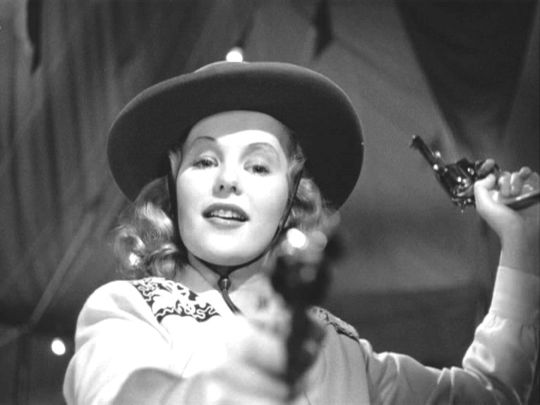
While Welles may have eulogized the genre with 1958's self-deprecating Touch of Evil, Lewis christened its rebirth a decade earlier with Gun Crazy, leading the genre's charge into a more chaotic and intensely introspective period. -- Christopher Justice [1]
Wroom, wroom, bang, bang.
These onomatopoetic words, often associated with the infantile, always seem to come to me when thinking of the right words for discussing 1950′s pulp film-noir. It was François Truffaut’s decision to include such words in the beginning of his review of a film by Samuel Fuller, and it is my decision to do the same in this essay about Gun Crazy (1950) by Joseph H. Lewis, another king of the B. The wonderfully straight-forward title of Lewis’ film -- which is, one might add, the more popular title in comparison to the alternative but equally outrageous Deadly Is the Female -- seems to outline its central themes: guns and craze. In this case, the latter does not only indicate psychic disintegration but also social and existential rapidity, that is, the hurry within man and his society, the being in the highest gear. Departing from the film-noirs which transcend the story by obfuscating narrative and plot, while resembling the film-noirs which transcend the story by simplifying narrative and plot, Gun Crazy never feels difficult or ambiguous due to the craze which reaches from the story to the level of form. It is evident to any viewer of the film that Gun Crazy can be grasped quite quickly as a three-act story, and this fact only emphasizes the depth of its wroom-wroom-bang-bang craze.
It begins with the juvenile yet ominous theft as a young boy (played by the young Russ Tamblyn, the future Twin Peaks star!) breaks the glass of a showcase of a gun store. His crime leads him to court which sends him to a boarding school. The gist of the first act concerns the boy’s return as a young man who has spent some time at the army after getting out of the boarding school. Accompanied by his two childhood friends, whose passion for guns was never as intense but neither was their disapproval of violence, the young man, named Bart, played by John Dall, visits a carnival where he encounters an alluring gunfighter the like he has never seen: mainly because she’s a she. The gunslinger from the opposite sex turns out to be a femme fatale who goes by the androgynous name Laurie, played by Peggy Cummins. The second act begins with the couple’s serene co-existence whose harmony is soon -- abruptly to the spectator, one might add -- interrupted due to Laurie’s ever-growing, demanding taste for the luxurious life, leading the duo eventually to the life of crime as bandits. Their happy life ends with the fatal heist of a meat packing factory whose failure puts a stop to their short-lived success. The third and final act depicts their constant run from the law which culminates in their death in the misty fields of desolation and poignant serenity.
Due to its obvious allusions to the strongly romanticized account of the criminal life of Bonnie and Clyde, Gun Crazy is easily associated with the great number of films taking inspiration from the legend, including Lang’s You Only Live Once (1937), Penn’s Bonnie and Clyde (1967), and Altman’s Thieves Like Us (1974). Yet it seems to me that Lewis’ film is best understood in connection not only to these “public enemy” stories but also to cinematic stories of mad love in general, that is to say, films such as Sjöström’s The Outlaw and His Wife (1918, Berg-Ejvind och hans hustru), Godard’s Pierrot le fou (1965), and Carax’s The Lovers on the Bridge (1991, Les amants du Pont-Neuf), which -- interestingly enough -- all revolve around lovers on the run.
These allusions capture something theme-wise, but the full understanding of the film’s context requires the appreciation of historical context. Gun Crazy is the first of the two films people usually have seen by Lewis, the second being The Big Combo (1955). Both are iconic film-noirs in the sense of developing and exploding archetypes. Both also include some of the most iconic shots associated with the genre: The Big Combo ends with the famous long shot of the female silhouette waiting for the man in fog, and Gun Crazy has the legendary sequence shot of the bank heist filmed entirely from the backseat of the couple’s getaway car. Both films also belong to the same period of the genre. If the classical era of film-noir ended with the final act of the Second World War after which the darker variation of the crime film turned into an even darker vision of a cynical world inhabited by disillusioned losers, representing the beginning of the new post-war era of the genre, then the final stage of film-noir is exemplified by the darkest variations of the dark crime film. It is the time when psychopaths, atom bombs, and hectically increasing hurry became emblematic of social and existential malaise. In this context, Gun Crazy finds its closest partners in crime in Aldrich’s Kiss Me Deadly (1955), Kazan’s Panic in the Streets (1950), Maté’s D.O.A. (1949), and Dmytryk’s The Sniper (1952).
Although this thematic and historical width of Lewis’ Gun Crazy opens the film up from its potential seclusion in eccentricity, it also challenges some genre conventions. According to film scholar Christopher Justice, Lewis’ film abandons narrative and visual conventions in using episodic structure, open spaces, and well-lit, daytime locations -- the antitheses for the iconic claustrophobic chambers of film-noir aesthetics [2]. While the story has the typical film-noir formula of a desperate, clueless man being driven into the lure of a femme fatale, the film does not reduce the woman into an embodiment of treacherousness (despite having the misogynistic alternative title), but rather uncovers the character as an archetype lost in authentic, even if utterly mad, love. Their love is mad because in the eternal symbiosis of Eros and Thanatos, their love engages with the lust for violence. Laurie might love Bart, but to her, love is always destructive and twisted. Nor does the film explain Bart’s desperate cluelessness by referring to any traditional situation of being cornered but rather to his existential strangeness and his desire to find a kindred spirit, a gun-loving soul lost in an unwelcoming world. In Spring Breakers (2012), they’d both be sucking guns.
From its title to its action, Gun Crazy is a film about guns which is why many contemporary spectators might find it hard to resist the temptation of locating Gun Crazy into the on-going debate about gun control which the rest of the world besides America is not having. Resisting the temptation or not, the way I see it, Gun Crazy is best understood when its gun theme is approached less concretely. In the era of sound film, guns seem to belong to the same category with cars and airplanes in that they are emblematic of a new age where transportation, violence, power, and social status are fundamentally changing. These technological inventions connote cultural pessimism, or the feeling that the new inventions have not improved our quality of life but rather have only accelerated our journey toward nothingness. With ironic thanks to modern medicine, we might be living longer, but we are also living faster and hence feeling like we are not living at all. We are “thrill crazy,” as the film’s poster describes itself. Guns carry a similar curse: "The film reminds us that guns are tools, instruments, and by-products of American democracy: they can build and destroy democratic states," as Justice sums up [3].
In addition to potential political meanings (bear in mind that one of the principal writers of Gun Crazy was the famous blacklisted scriptwriter Dalton Trumbo), critical literature on the gun theme of Gun Crazy is rife with psychoanalytic interpretations [4] which, to my mind, should not be considered exhaustive but rather the other side of the film-noir coin: for the dark genre is always best understood as the bastard child of wartime anguish, postwar disillusionment, existentialism, and psychoanalysis, all of which were cutting through the western world in the 40′s and the 50′s. As a result, the full understanding of any film-noir seems to require a holistic perspective which looks at the films from different viewpoints. To me, these viewpoints are best united when put together under the rubric of the films’ style and narrative.
In allusion to psychoanalysis, Gun Crazy begins with childhood and the lack of parental guidance. It begins with the young Bart’s obsession for guns which, despite eventually leading him to the life of crime, is not associated with violence. At court, Bart’s big sister a.k.a mother figure tells the story of Bart feeling deep remorse for once killing an innocent bird. Bart’s obsession for guns is different. Bart explains that shooting is the only thing he’s good at, and that upon shooting “it’s like I’m somebody.” Given the obvious phallic metaphors guns lend themselves to, it has become something of a standard interpretation to see Gun Crazy as an oedipal story. After all, Bart does not have a mother nor a father. Therefore, the entrance of Laurie into his life is phenomenal: Justice claims that “[p]sychosocially, she is Bart’s Oedipal mother and first love, but she is also the father figure he must compete with for approval” [5]. This seems most evident in the androgynous appearance of Laurie, who refuses to wear skirts to work and whose male outfit at the carnival is juxtaposed with her womanly figure emphasized by composition and lighting.
In true Lacanian expansion of Freudian ideas, the perennial oedipal complex which torments Bart’s existence manifests itself outside his relationship with Laurie in the society in general. It is clear to the spectator from very early on that the state has failed to help the boy without parents. The police officer in the beginning, the judge at the court, and the military forces all just pass him along. Without Laurie’s appearance, the capitalist carnival would have done the same. Unlike a Dickensian orphan, Bart does not end up in an abusive foster home or to an eccentric life of great expectations, however; rather he becomes a drifter who turns into a menace to society due to his rootlessness. To Justice, “Gun Crazy is fundamentally a visual and narrative rejection of the state, and Bart’s ‘fatherless state’ is a metaphor for America’s profound ineptness” [6]. Bart and Laurie are strangers to the mainstream; hence they abandon the state, they abandon bourgeois work, and they abandon traditional, “rational” love even at the expense of their life.
Both Laurie and Bart have a thirst for shooting. It’s what they’re good at. The gun is the phallos which Bart obsesses over due to the absence of his parents; it is the phallos which Laurie obsesses over due to the absence of male genitalia. They transfer their lack to guns which come to embody the object petit a, the unreachable object of desire which is now within arm’s reach. Laurie the woman is not as good at shooting as Bart the man -- though just by an inch, or by a match -- but she is a much more powerful figure since her obsession is deeply tied to violence. Bart can stop this destructive force in Laurie, the force that is now within him as well, only by shooting her which also leads to his own demise by the bullets of the police. He had to die. The woman, the force, the violent craze had become his raison d’être, the very condition of possibility for his existence.
While it’s all fine and dandy to throw around Freudian and Lacanian ideas when discussing films which really lend themselves to such discourses, I find it necessary to locate the social and psychological interpretations of the film in a wider context of narratology and stylistics which are captured by a phenomenological interpretation of the film [7]. As such, Gun Crazy is an existentialist tale of being which discloses crazy being through a crazy tone.
The crazy tone of Gun Crazy stems from Lewis’ narrative which is incredibly ardent, fast-paced, and economic. Take the first scene, for example. A boy and a showcase. The boy breaks the glass and takes a gun behind it. As he runs away, he slips in the rain and the stolen gun rolls to the feet of a police officer. Cluelessness and gun mania have been told to us about the protagonist. The next scene is the courtroom scene where we first hear witness accounts from other characters -- and see flashbacks focalized into their point of view (read: Bart’s perspective is conspicuous by its absence). Not until the very end of the scene do we hear what the boy himself has to say (”it’s like I’m somebody”) -- and with no focalized flashbacks. As the judge reads the sentence, Lewis’ camera slowly tracks toward the young Bart’s ear. By this subtle cinematic gesture, Lewis’ stark narrative emphasizes the strangeness of the boy, his state of being an outsider: he can hear, but he is not being heard. The external perspective prevails at the expense of the inner -- his strangeness cannot be understood. And it hurts because it is true. As the camera briefly lingers on Bart’s ear, the judge says from the off-screen space that the boy is to be put to a boarding school “until further notice.” What follows is a match cut from the ear to a telephone which Bart’s sister answers. The match cut, of course, cuts from Bart’s childhood to his adulthood. Nothing of his in-between adolescent years is told to us. Instead, narrative moves forward with a fervent speed.
In congruence with the rapidity of the tone, there are many single shots in the film which contain a lot of diegetic information that has been packed up economically: a journalist speaks about the robberies to a radio microphone and newspaper headlines fly toward the camera. Narrative economy is also characteristic for the film’s many montage sequences which cover the couple’s honey moon, their first series of heists, the media coverage of the heists, and an ever-growing police chase. Considering the film lasts less than 90 minutes -- that’s a lot of montage sequences. A certain mood of rapidity, hectic, and hurry characterizes these scenes. The mood takes over the whole of the film. A single shot where Lewis uses framing to connote meanings and feelings can be found in the scene where Laurie convinces Bart to do the one last heist of the meat packing company: as Laurie makes her demand, Bart lifts his head momentarily out of the screen into the off-screen space as if his cluelessness reached a peak, a new limit of despair, went beyond it, out of the screen space, and thus anticipated his voyage to non-existence accelerated by bullets. Before the journey, however, his head returns to the screen space to be convinced by Laurie’s embrace. Like the lingering shot of Bart’s ear at the trial, this shot also enhances the feeling of strangeness, being an outsider, being under the power of someone else by framing the character’s face off.
The ultimate moment of economic narrative is, of course, the film’s bravura shot, the robbery scene which is executed with one long sequence shot. At first glance, this Bazinian shot, which emphasizes duration, depth, and continuity, might seem contradictory to the aesthetics of hurry and craze I have been attributing to Gun Crazy. After all, Lewis’ decision to rely on such stylistic realism might remind one more of Italian neorealism and the quasi-documentary film-noir it inspired (The Naked City, 1948; Call Northside 777, 1948; The Set-Up, 1949) and, as such, the sequence shot might seem to stick out like a sore thumb -- given that there are no other shots like it in the entire film. On the other hand, this famous shot feels so modern that it could have been made convincingly in some nouvelle vague film. Godard’s Bande à part (1964) is the first which comes to mind since it makes homage to many film-noirs, Gun Crazy included. Taking this association into consideration, the shot does not seem to stick out so strongly. In Justice’s words, “Lewis’s contradictory, inconsistent style may be the most distinguishing characteristic of his directorial ethos, which reveals a radical departure from his contemporaries’ predictable technical and thematic approaches to genre, particularly film-noir” [8]. At best, the shot might be representative of Lewis’ aesthetic transgression anticipating the Godardian combination of Bazin and Eisenstein. In the end, maybe the enigma of the shot draws the spectator’s attention to time and movement, the fleeting Heraclitean flux of moments in the stream of which the modern man is about to burst into pieces, exploding in the intensity of a car crash and a gun bang.
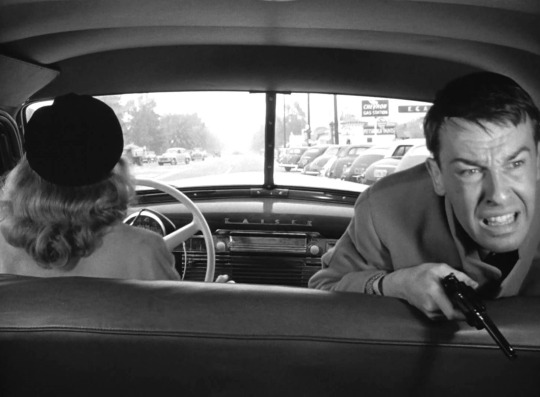
Rapid narrative, which provides diegetic information in a concise, economic fashion, is not necessarily a virtue on its own, but the way Lewis uses it in Gun Crazy certainly is. The crazy narrative reflects the mode of the characters’ being in the world. When Bart is telling Laurie about the fear he felt as he was shooting at the police car chasing them (Bart’s moment of guilt which the spectator associates with the earlier witness accounts of the dead bird and Bart’s subsequent reluctance to shoot a mountain lion because of that), he describes his feelings in a desperate tone: “It’s like everything was in high gear.” When Bart says these words, he is driving a car. He is driving the metaphor of the modern world, the vehicle partner of the gun, the wroom of the bang. It’s the only thing present in the surrounding environment that he can identify with. The car -- like the gun -- is an essential part of his being. The hectic and tormenting hurry which characterizes his existence to its core, but also feels strange and unhomely. He is in a way which he would not want to be, but he can’t help it. His being is in the highest gear toward nothingness. Recalling Godard’s Pierrot le fou -- and Godard was, of course, an admirer of Lewis --, Ferdinand, the protagonist of the film, looks into the mirror of his car and says that he sees nothing but “the face of a man who is driving towards a cliff at 100 km/h.” Ferdinand’s lover, Marianne, comforts him by saying that she sees “a woman who is in love with the man.” Similarly, Laurie tries to comfort Bart by saying that “at least we have each other” which is followed by Bart’s laconic reply: “but the rest is torture.”
It seems obvious that Bart is talking about the criminal life the couple is having (he would not have made the comment during their honey moon), but the fact of the matter is that this modern life of carelessness, enabled by their gun crazy ways, is the only life they could live. Thus Bart is speaking nothing but experienced truths about his mode of being in general, the being in the highest gear, which is exemplified by Lewis’ cinematic narrative.
If the rapidity, the cars, and the guns indicate the modern world, the breakdown of the couple’s getaway car in the middle of a forest road, while being chased by the police, and the following departure into the woods where they get lost indicate their final aberration from the modern world, the only life they knew, and the life they could not continue. Their aberration into nature denotes the approaching arrival of death, the burnout of their existential battery. As the day begins to dawn, they wake up on the misty fields where they are to die self-destructively -- in the rapid blink of an eye. There are no more sounds. There is no onomatopoeia for death.
Notes:
[1] Justice 2012, p. 228.
[2] Ibid. p. 237.
[3] Ibid. p. 231
[4] See Justice 2012; see also Lee 2012.
[5] Justice 2012, p. 229.
[6] Ibid. p. 233.
[7] What often lacks in political and psychoanalytic interpretations of films is an attentive discussion on style and narrative. Though this is hardly the case in every situation, I find it better to enrich those interpretations with a wider context of a phenomenological approach which appreciates the relations between the film’s topic, theme, narrative, and style.
[8] Justice 2012, 225.
References:
Justice, Christopher. 2012. "Rejecting Everything: Gun Crazy and the Radical Noir of Joseph H. Lewis". In Gary D. Rhodes (ed.) The Films of Joseph H. Lewis. Detroit: Wayne State University Press, p. 223-241.
Lee, Michael. 2012. “Music, Masculinity, and Masochism in Gun Crazy”. In Gary D. Rhodes (ed.) The Films of Joseph H. Lewis. Detroit: Wayne State University Press, p. 242-254.
5 notes
·
View notes